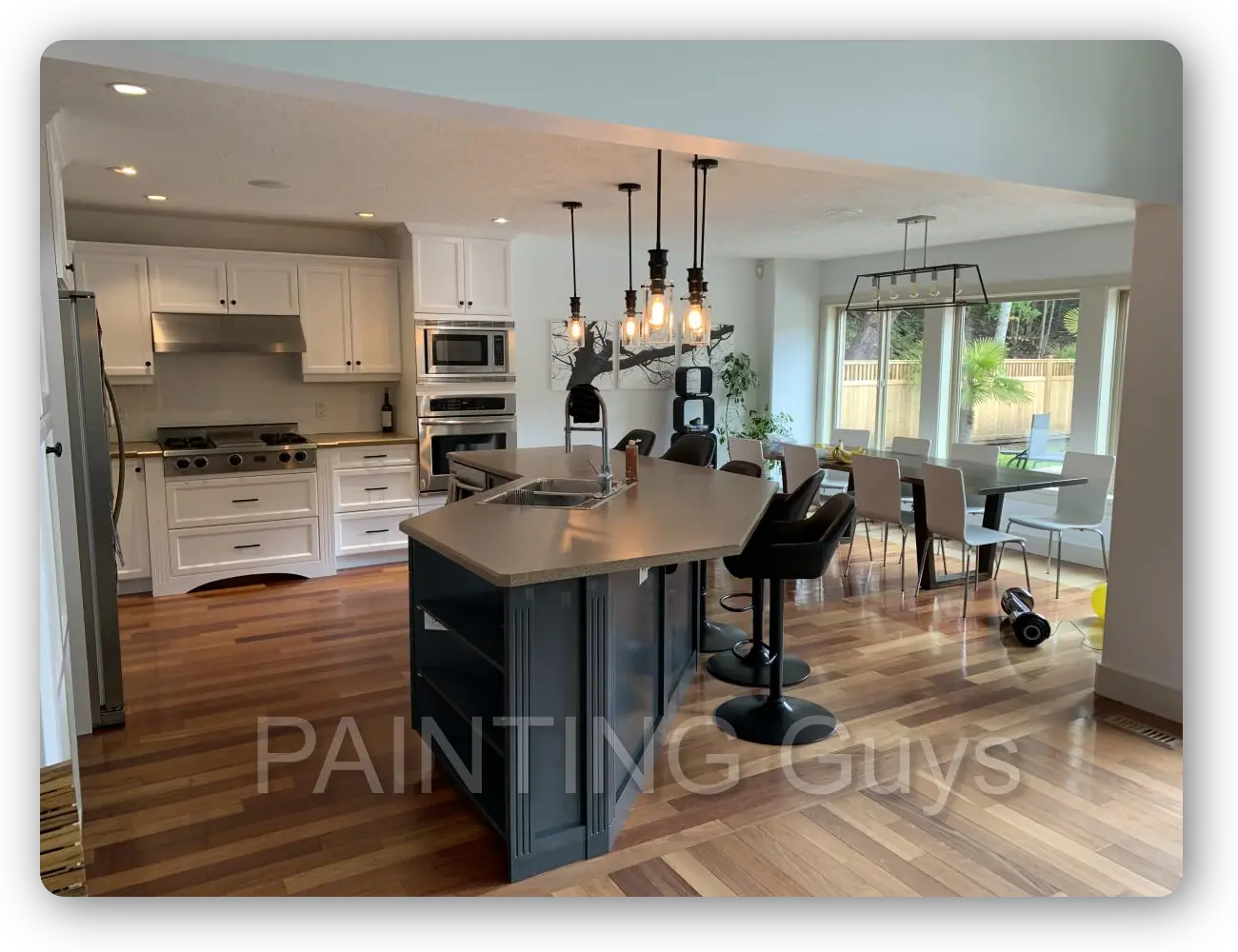High-quality kitchen cabinet painting, including bathroom vanities, bookcases, fireplace surrounds and more...
Serving Edmonton to Lloydminster, Alberta
"We don't just paint over kitchen cabinets, we refinish all types of cabinets and vanities to look like new again."
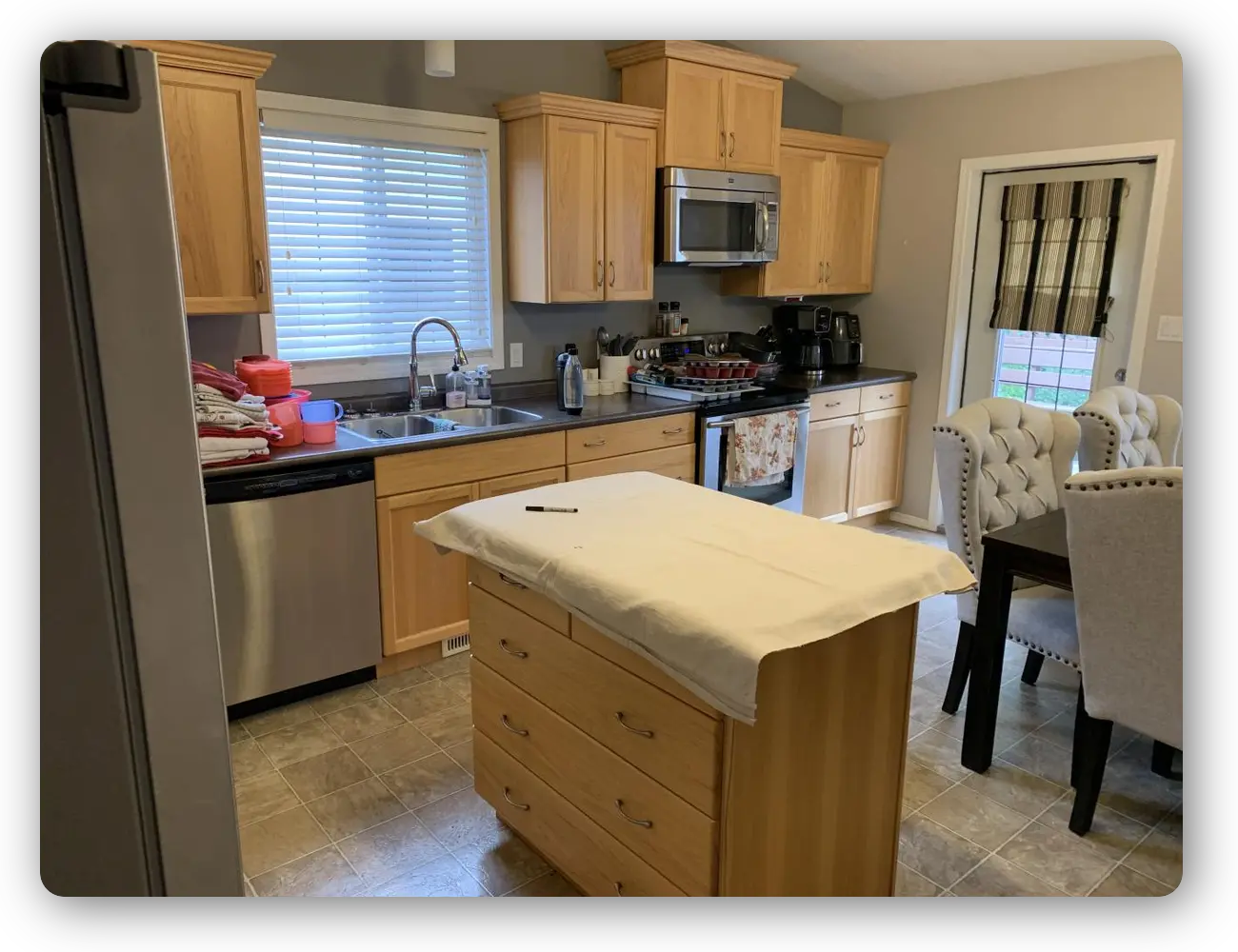
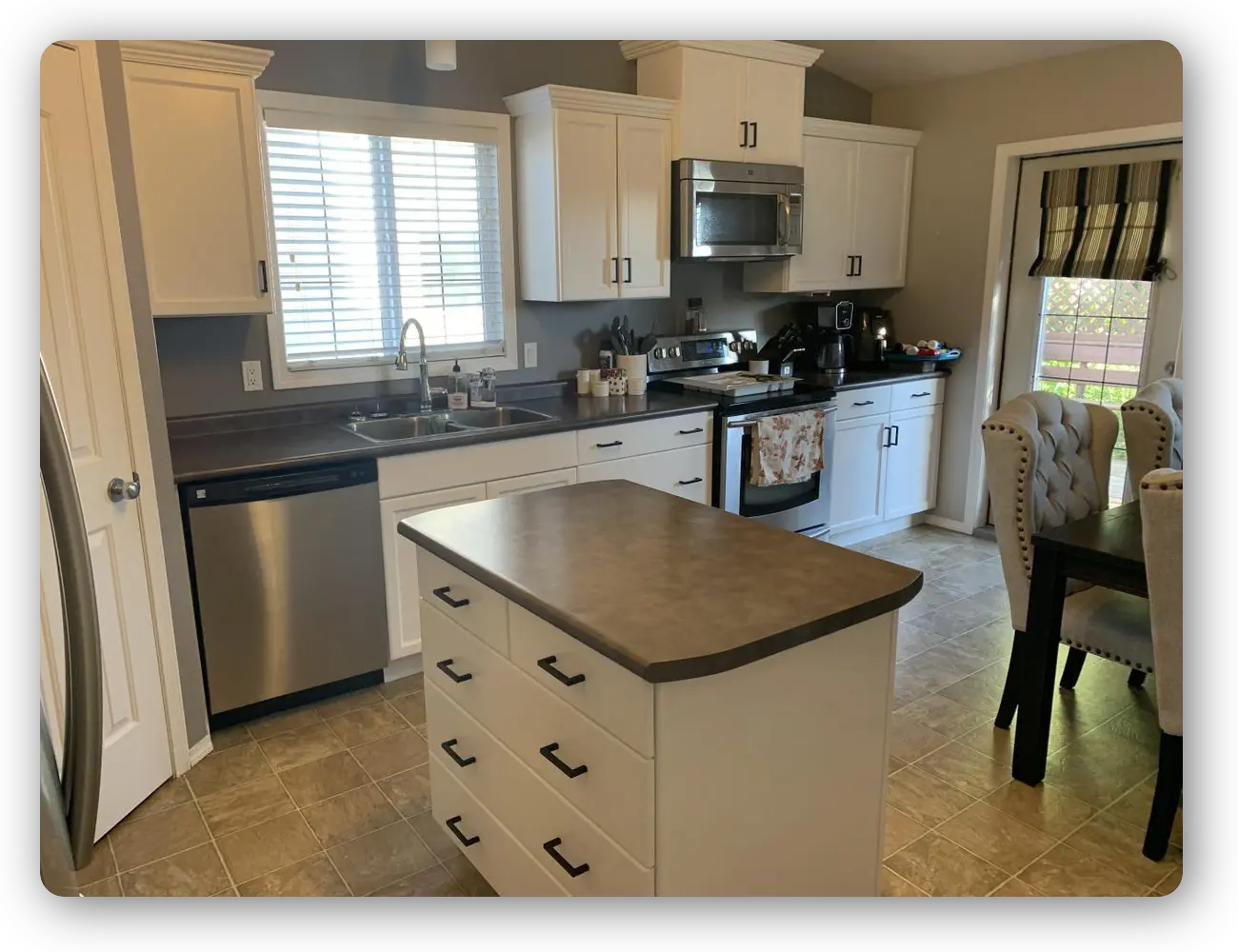
No messy construction
You do not need to empty cabinets, drawers or cupboards!
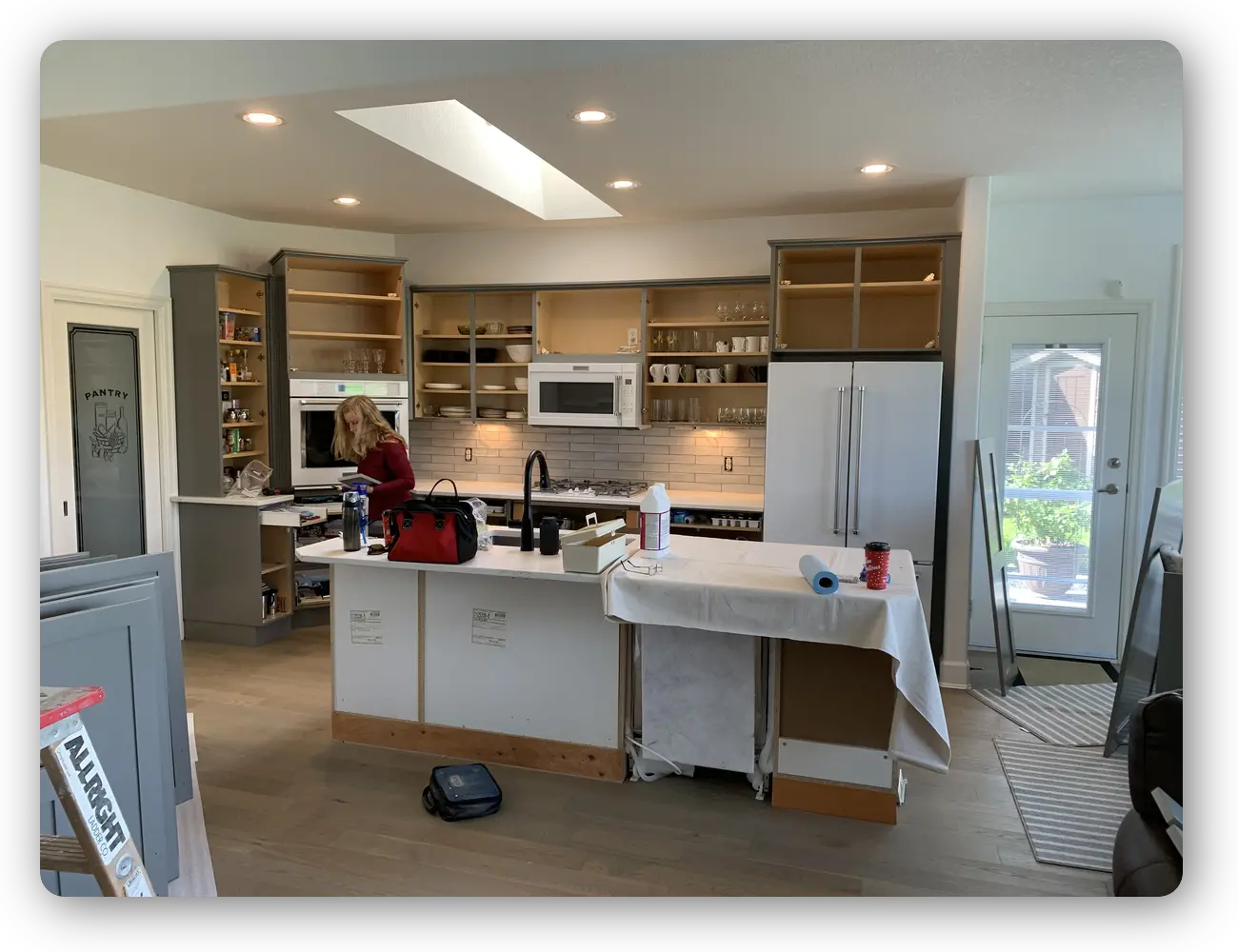
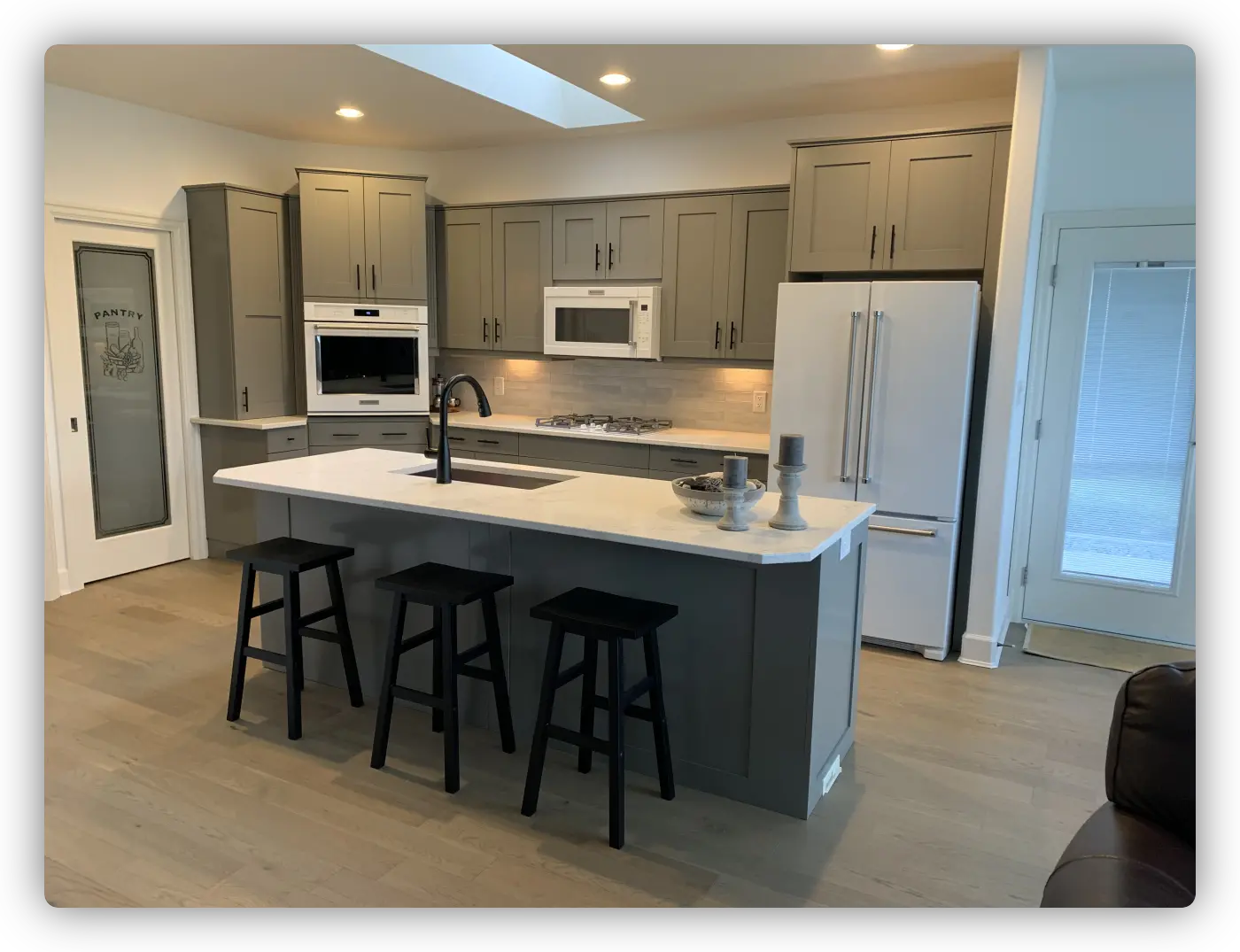
Durable long-lasting satin smooth finish
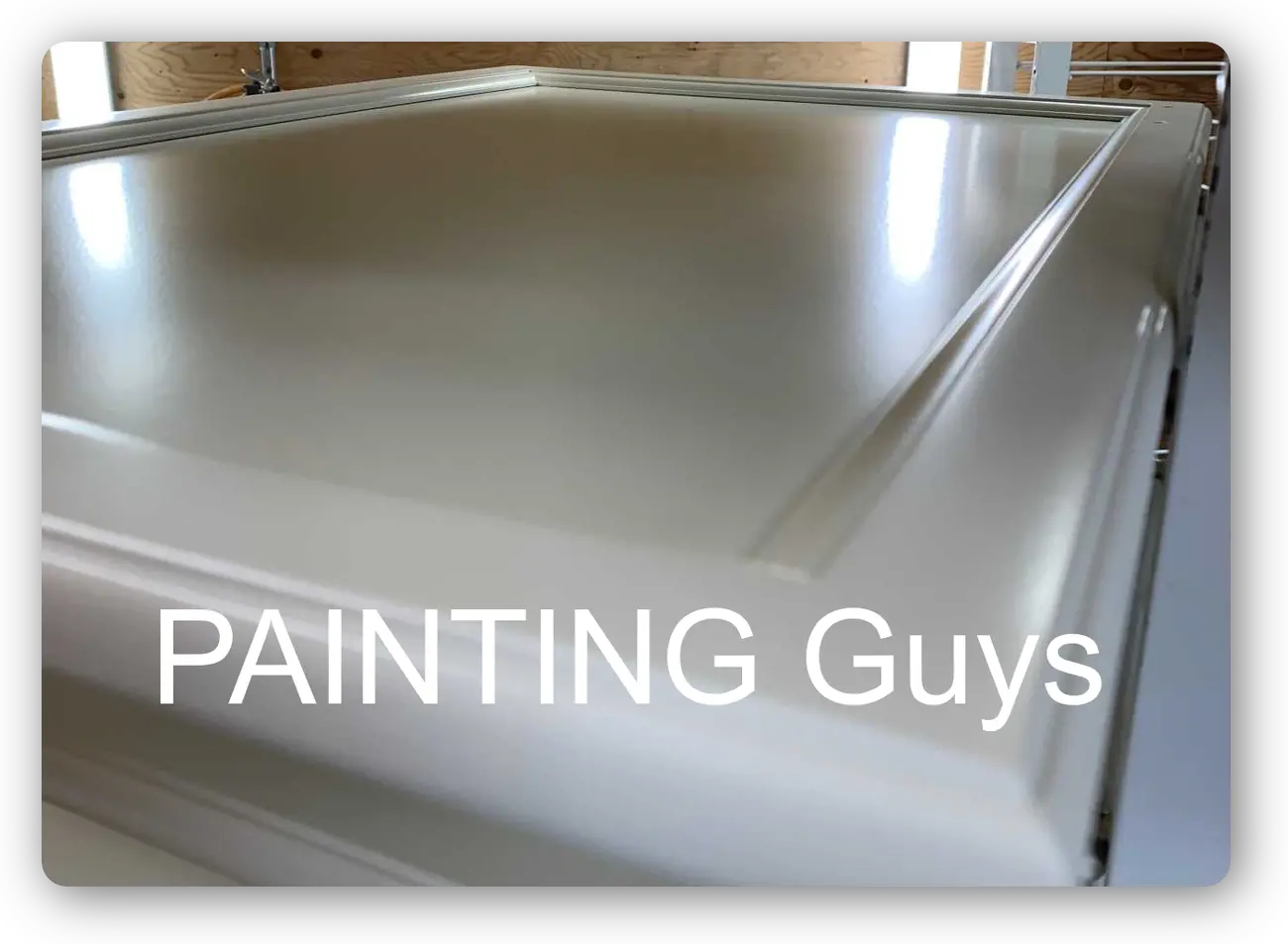
Beautiful cabinet colours!
Paint oak, maple, MDF and even thermofoil cabinets in any colour you like.
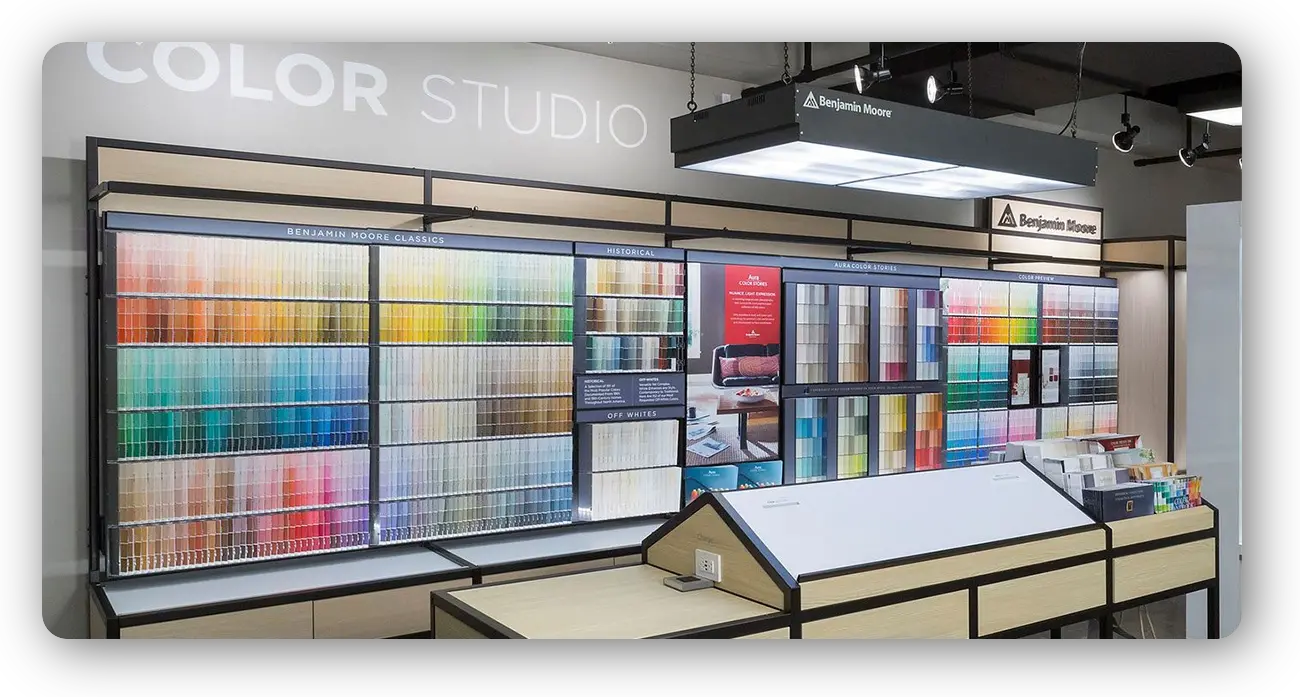
Two-tone colour combinations
If you want more than one colour or shade of white consider painting an island or even the top and bottom two different colours.
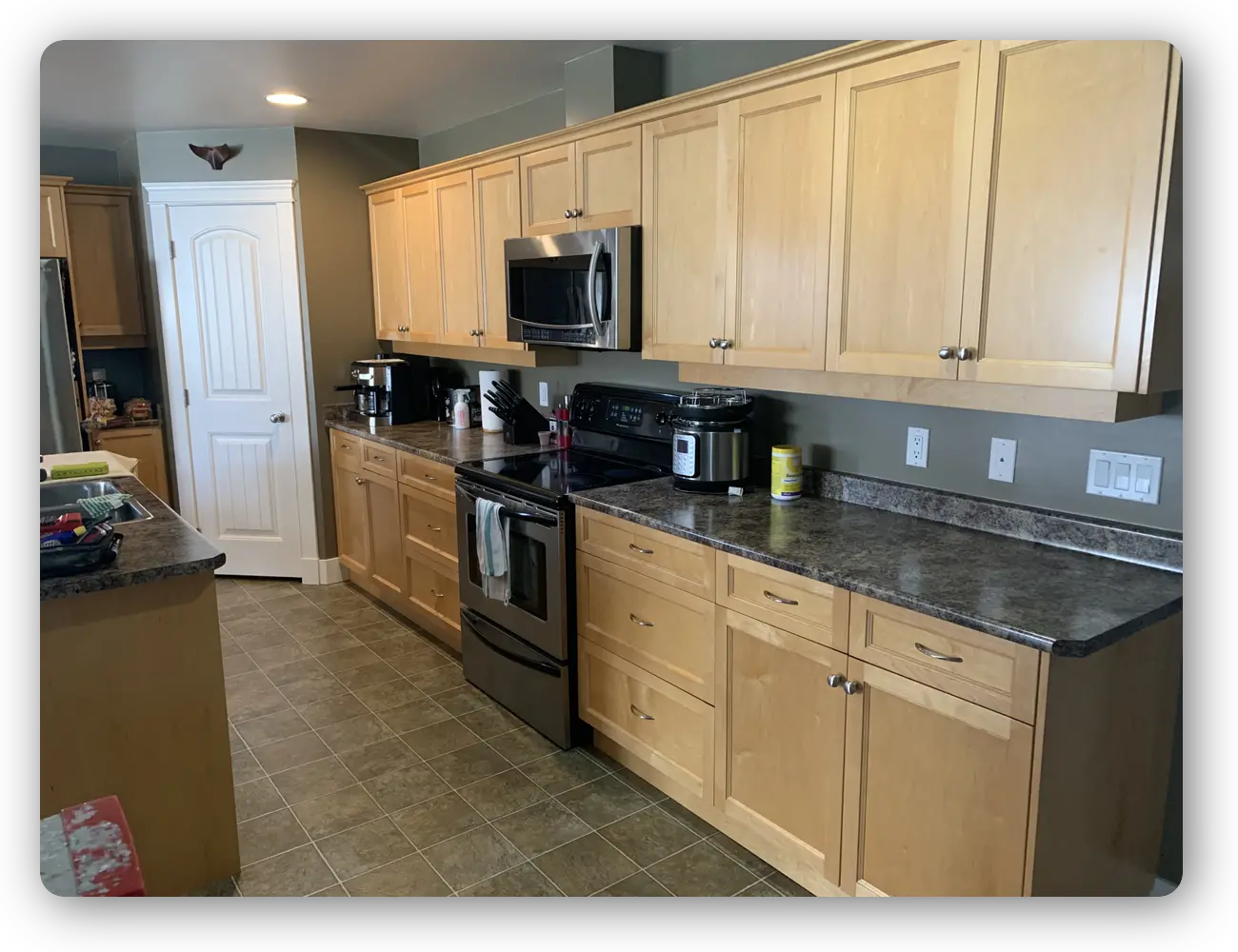
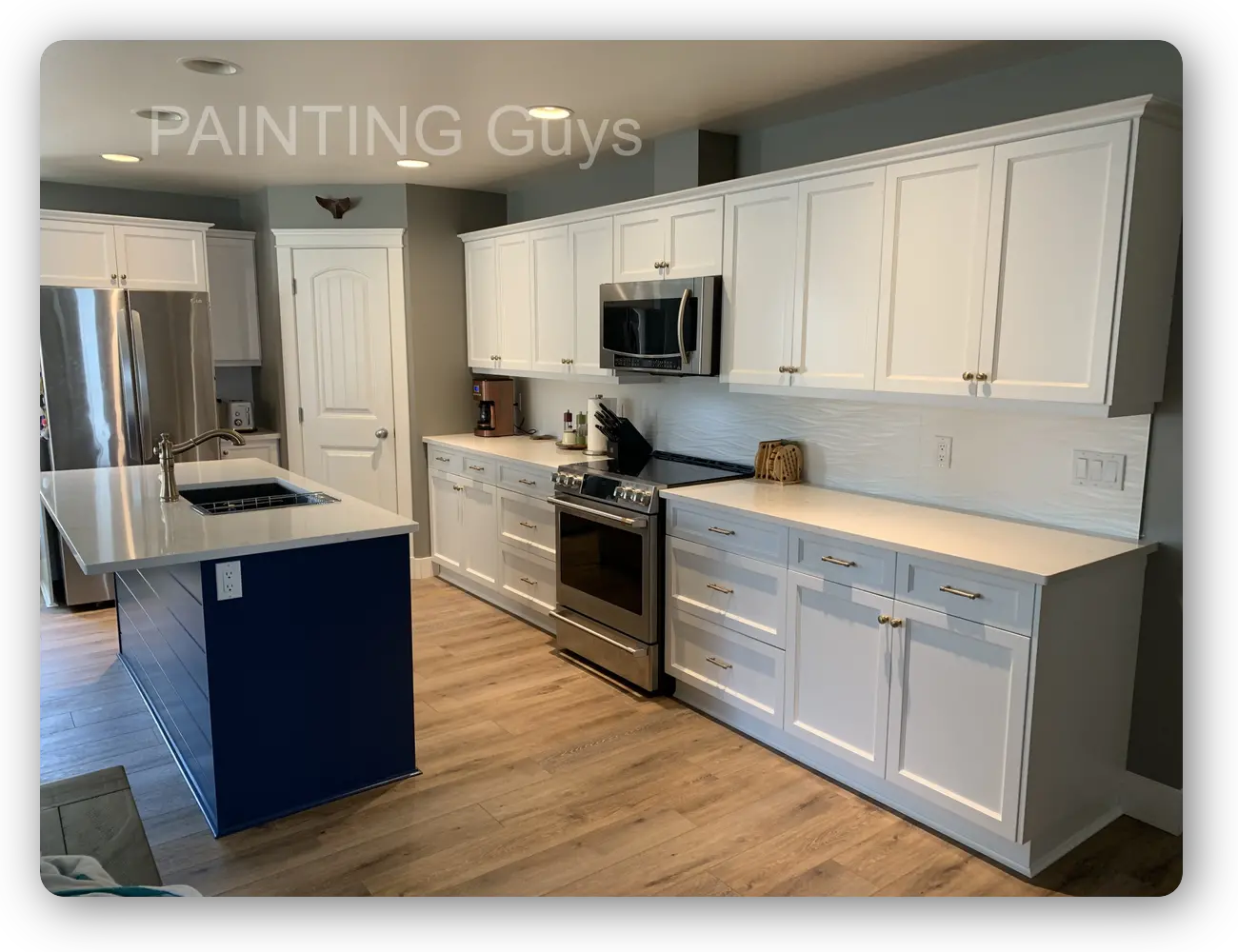
Paint bookcases, open shelving, wall units and more...
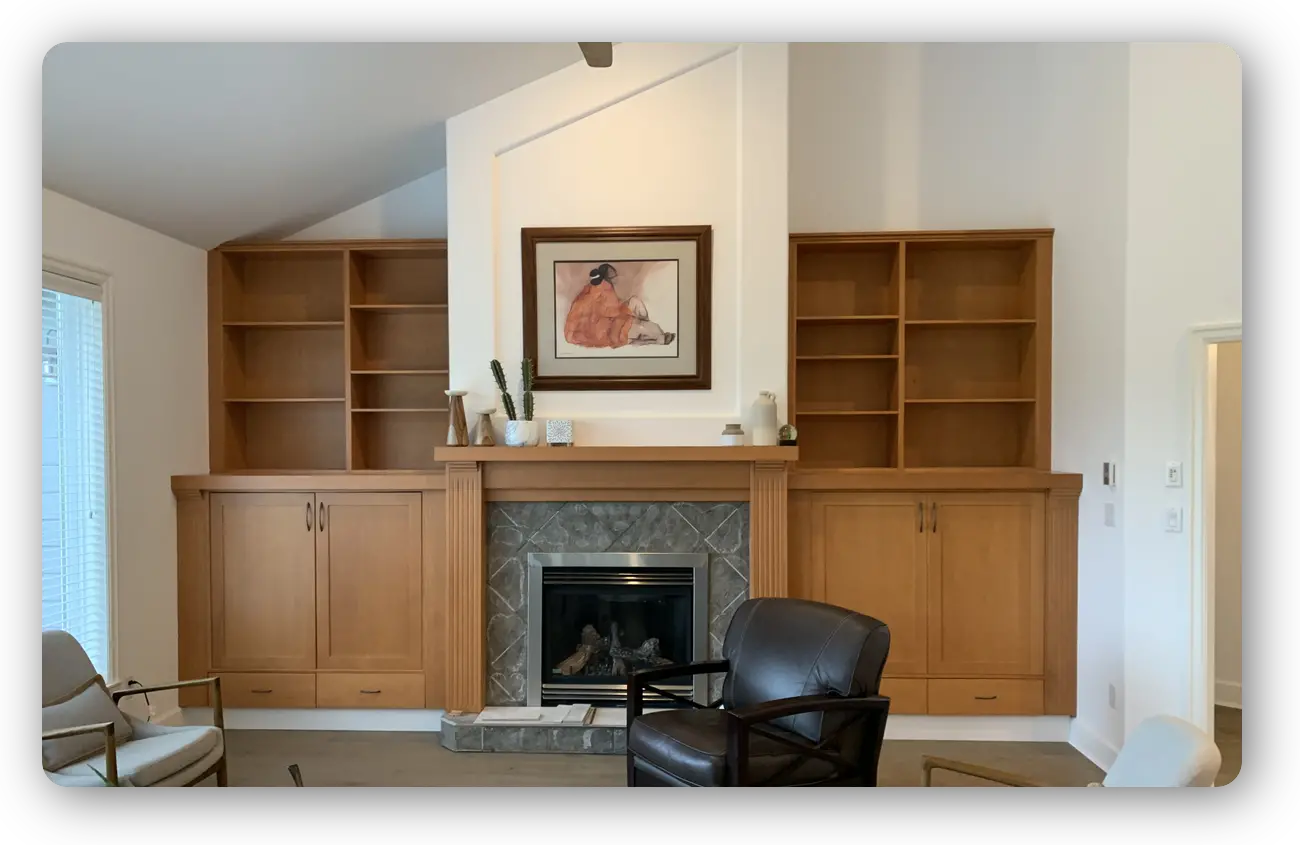
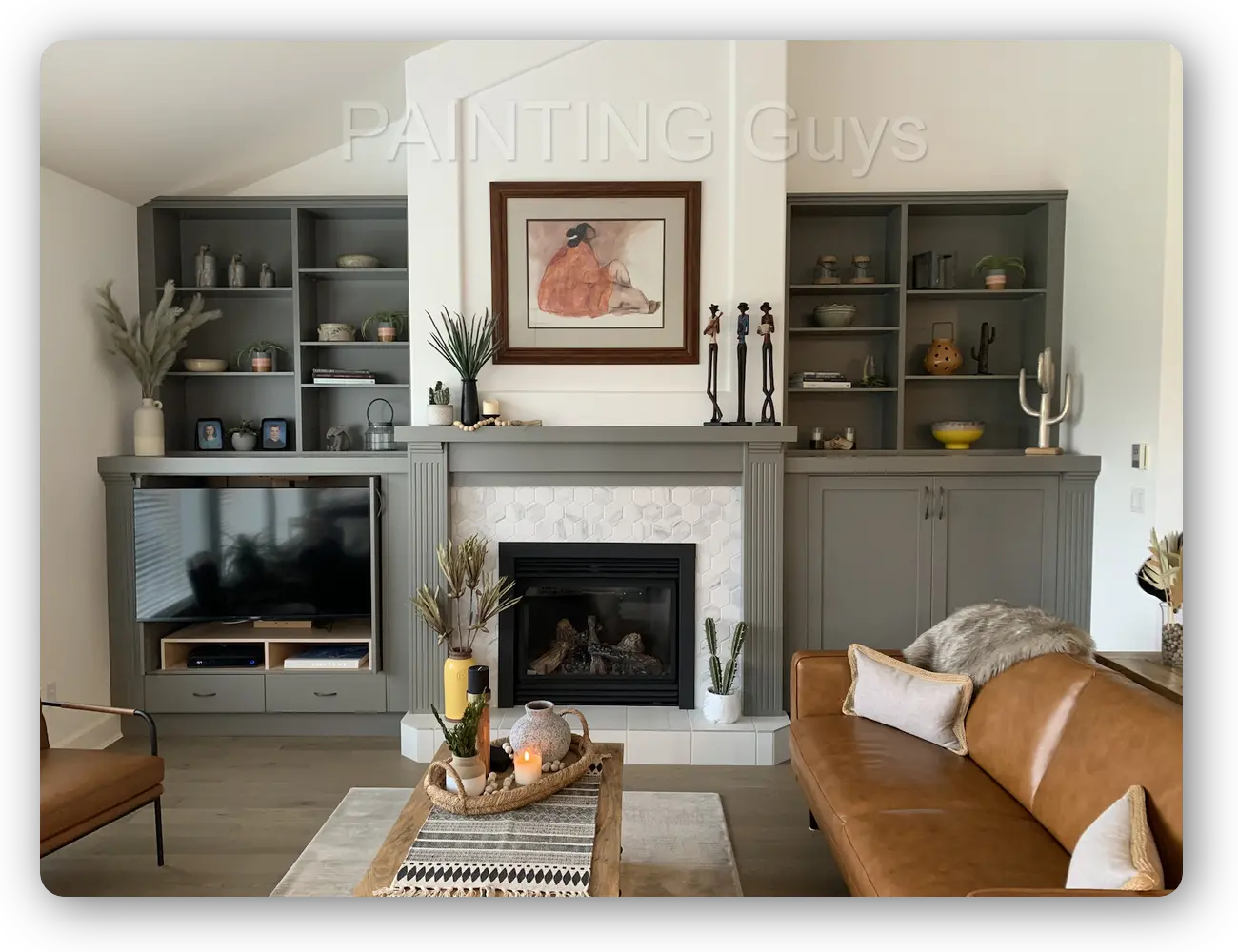
Paint bathroom vanities
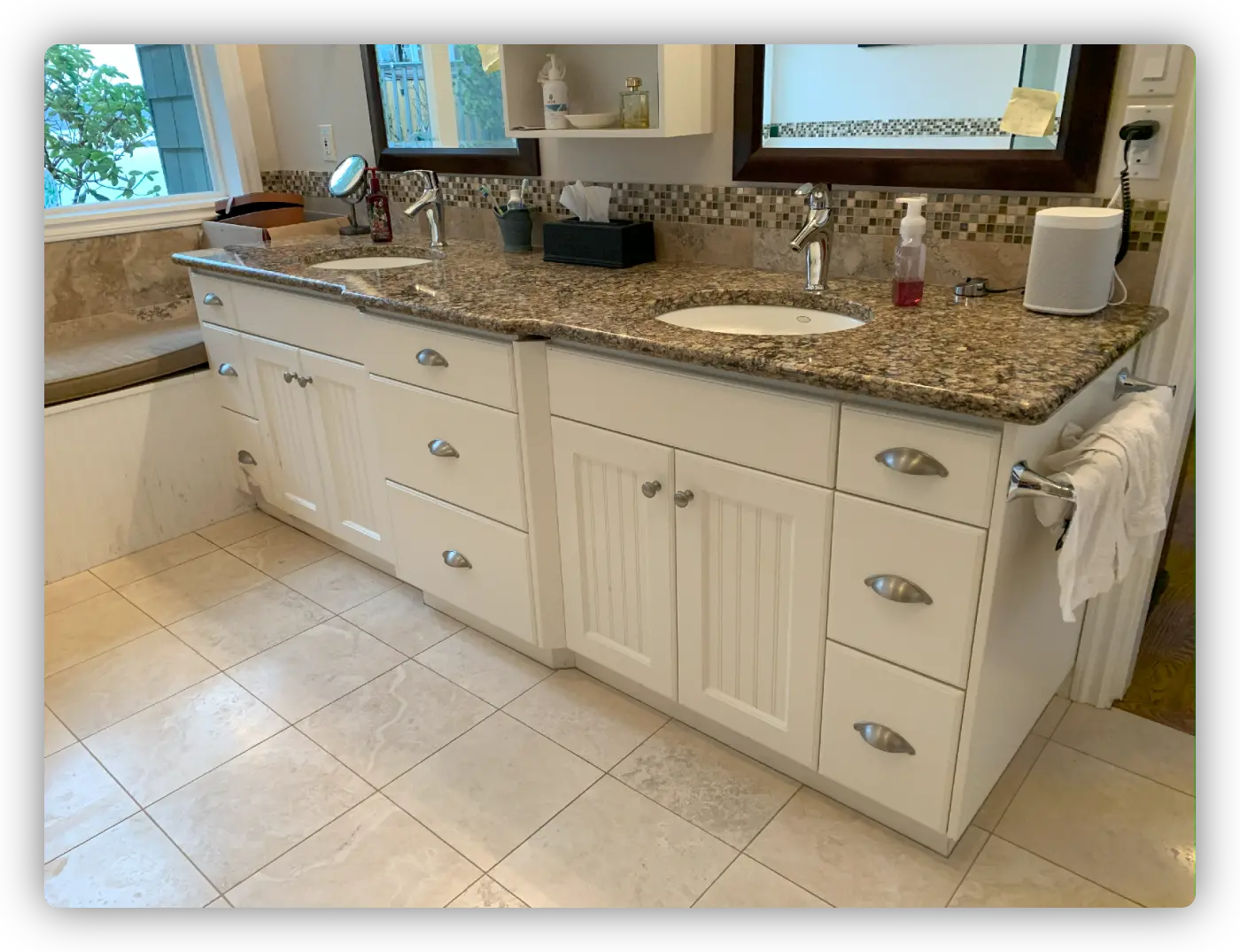
Costs
The average cost to paint kitchen cabinets is between $3,500 and $6,500. This includes sanding, spray finishing, all labour, paint, and supplies.
Costs are based on:
- Number of cabinet doors and drawers there are in total;
- Type of wood (oak, maple, pine, melamine etc);
- Profile and design of cabinets;
- One or more colours;
- Overall condition.
Cabinet Painting FAQs
Is painting kitchen cabinets a good idea?
Painting kitchen cabinets is one of the easiest and most affordable ways to give your kitchen a brand-new look. If you are happy with the layout of your cupboards, you do not need to replace or reface them.
By selecting the right colour and hiring a professional cabinet painter homeowners can significantly increase their property's value and overall appeal.
Can all types of cabinets be painted?
All wood products including laminates, melamine, and even thermofoil cabinets can be beautifully painted.
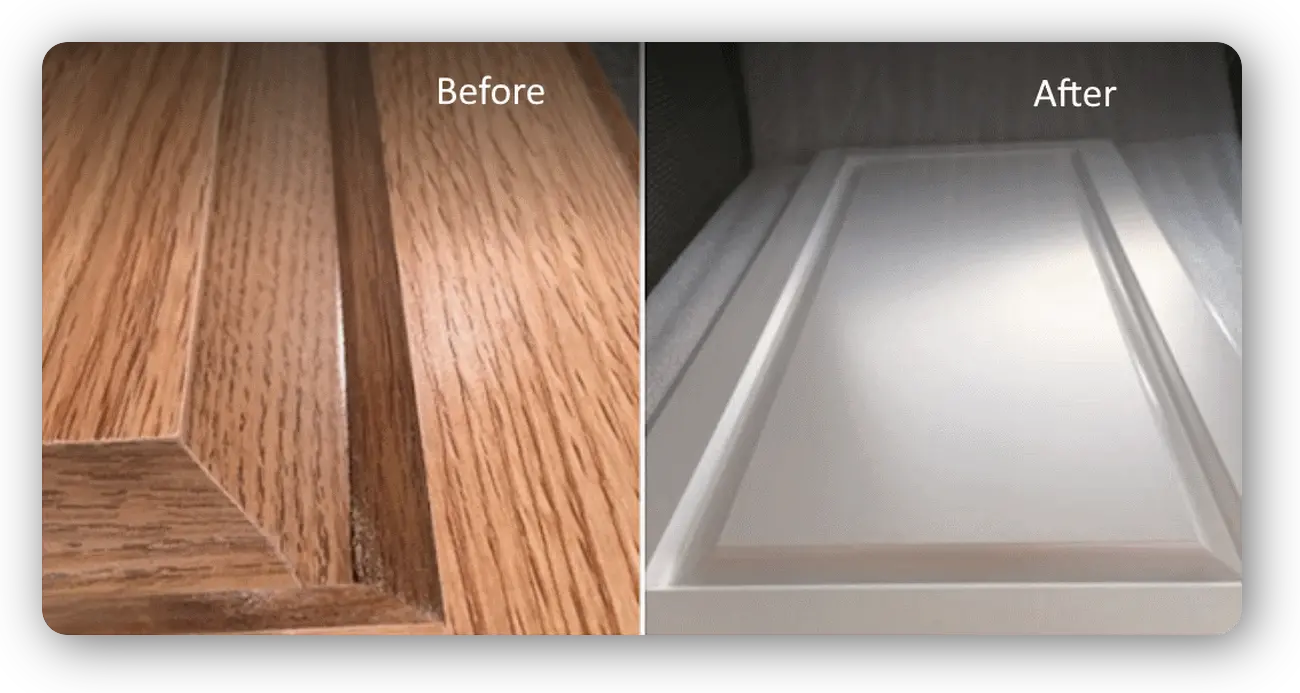
When do you decide to paint your kitchen cabinets?
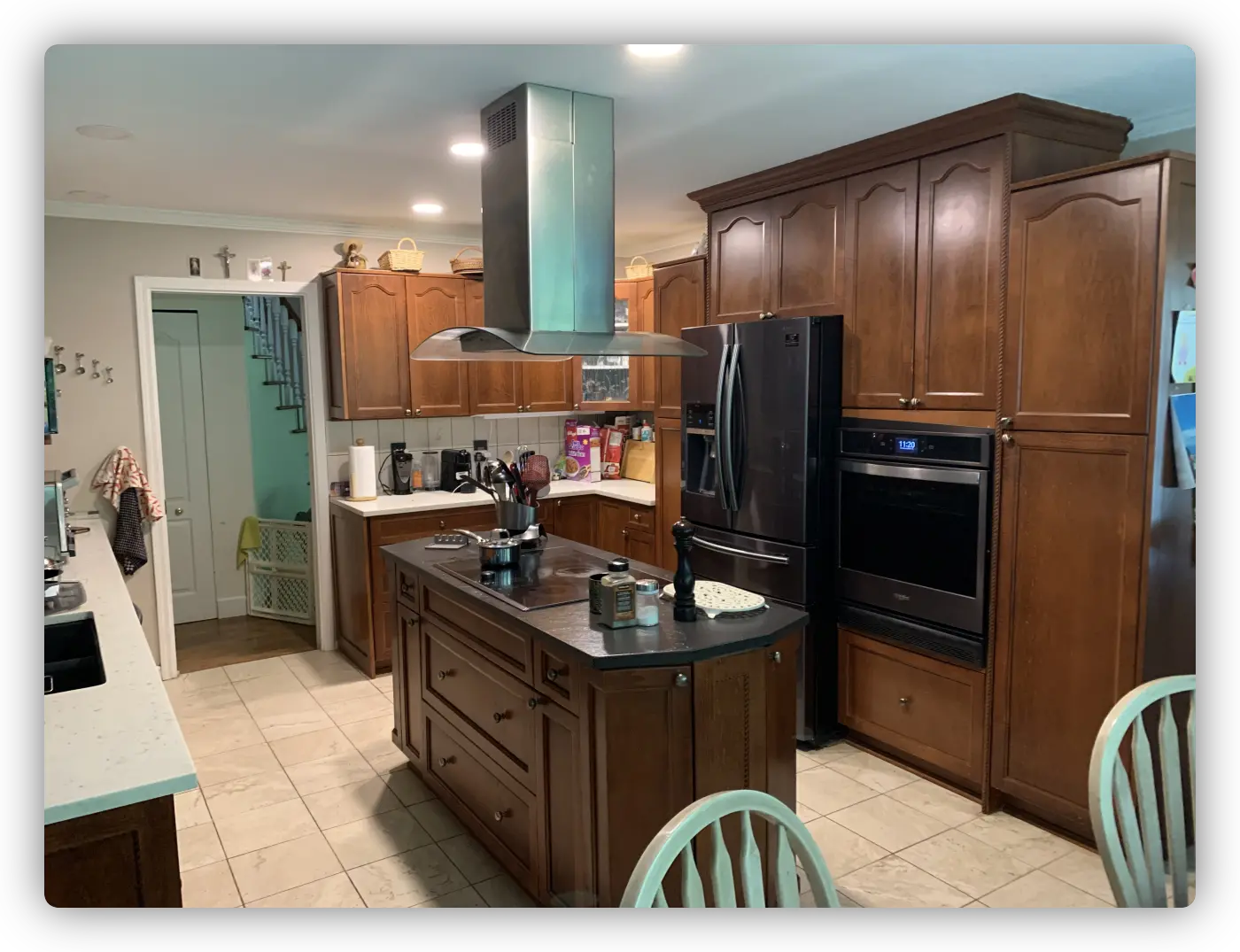
Before
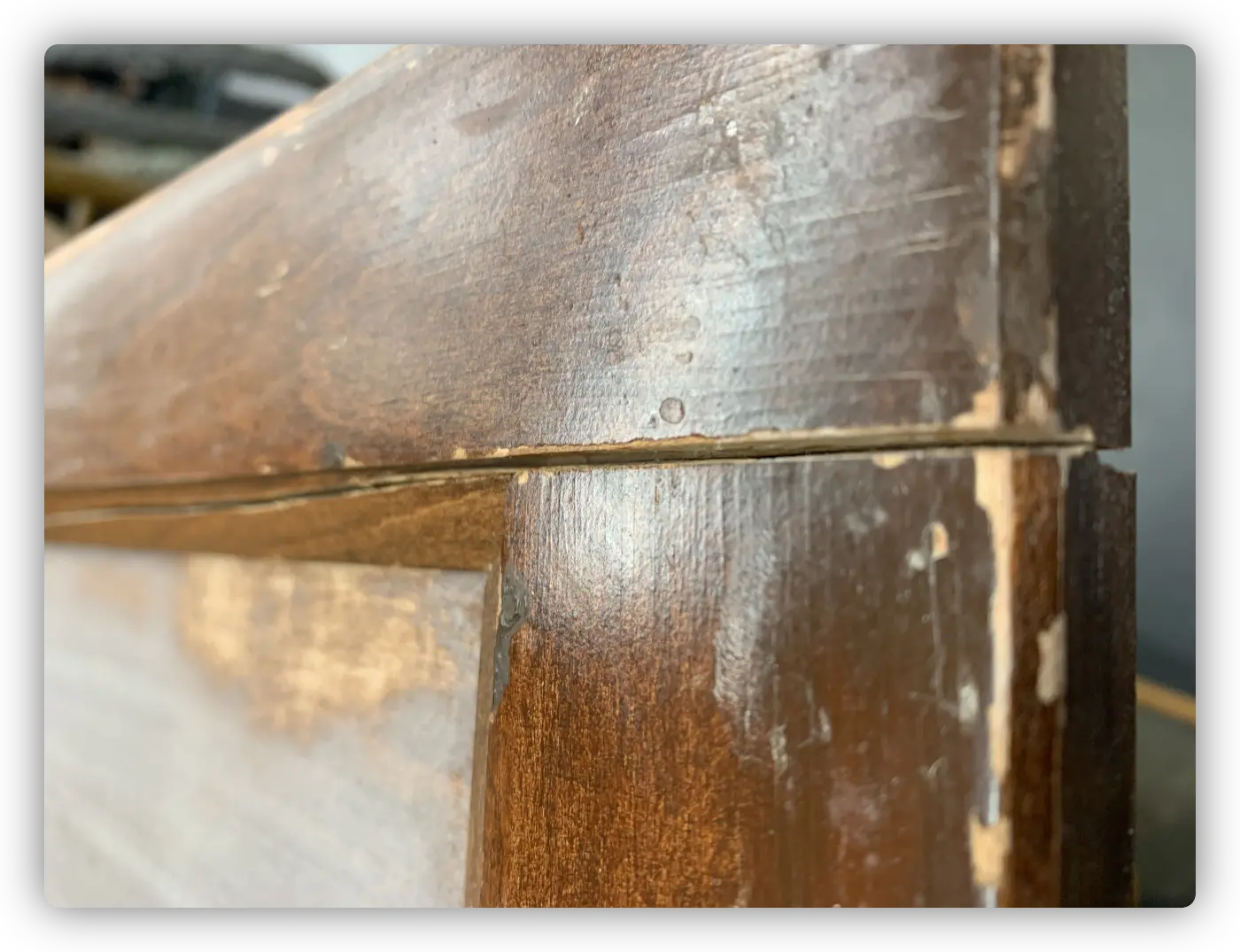
After
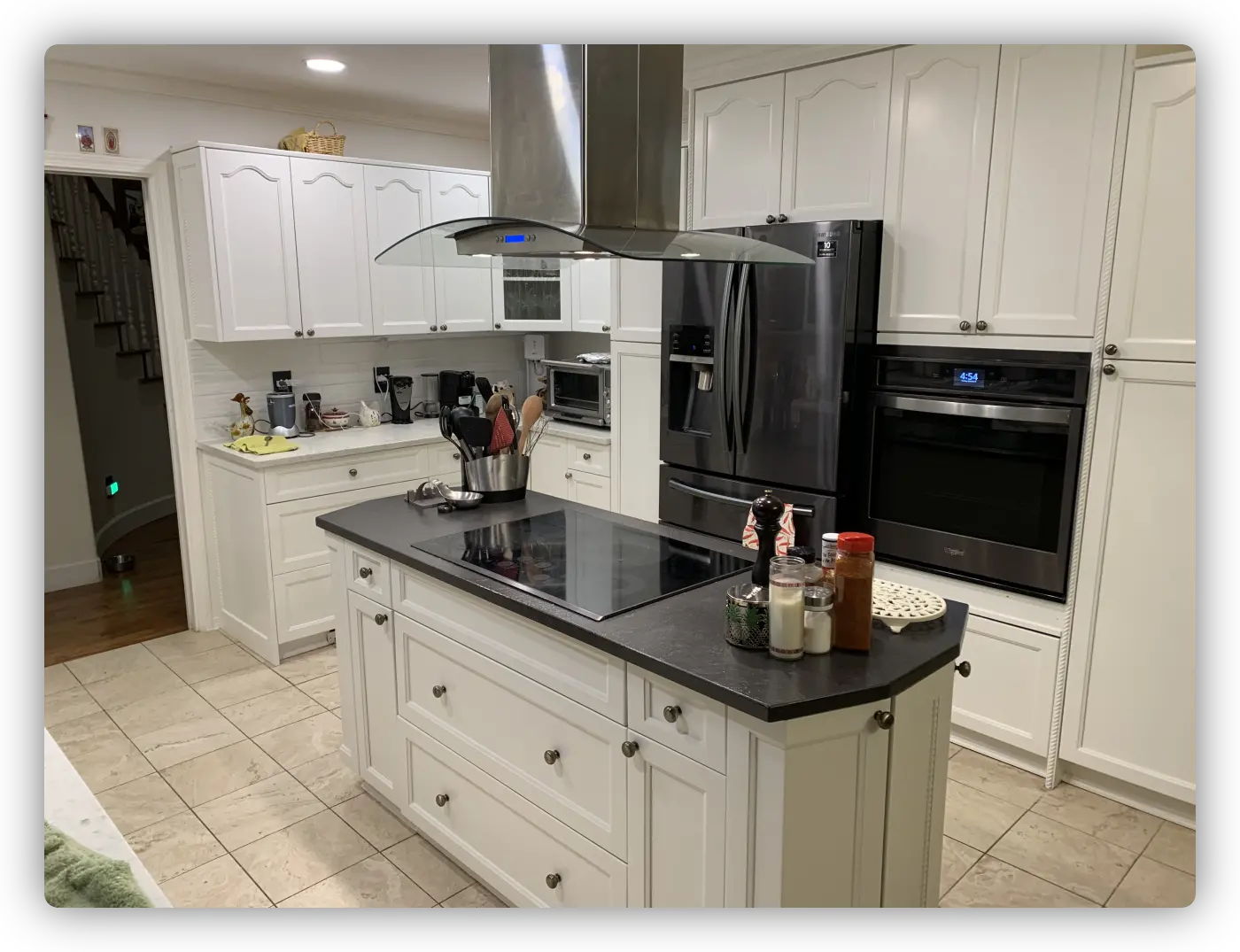
How long does kitchen cabinet painting take?
The average time to properly paint kitchen cabinets is usually around 10 days.
Our process:
- Align doors and drawers before disassembling;
- Remove and label cabinet doors, drawer fronts, and hardware;
- Clean the cabinetry (DO NOT soak or use TSP);
- Patch and repair scuffs, nicks, and dents and allow to dry;
- Sand exterior cabinets, doors, and drawers;
- Vacuum or air blast everything;
- Apply shellac primer until opaque;
- Caulk solid seams and cracks and allow everything to cure for a minimum of 24 to 48 hours;
- Sand everything again and prime where needed;
- Paint the kitchen cabinets;
- Reassemble;
- Install new felt bumpers on doors and drawers.
Step 1
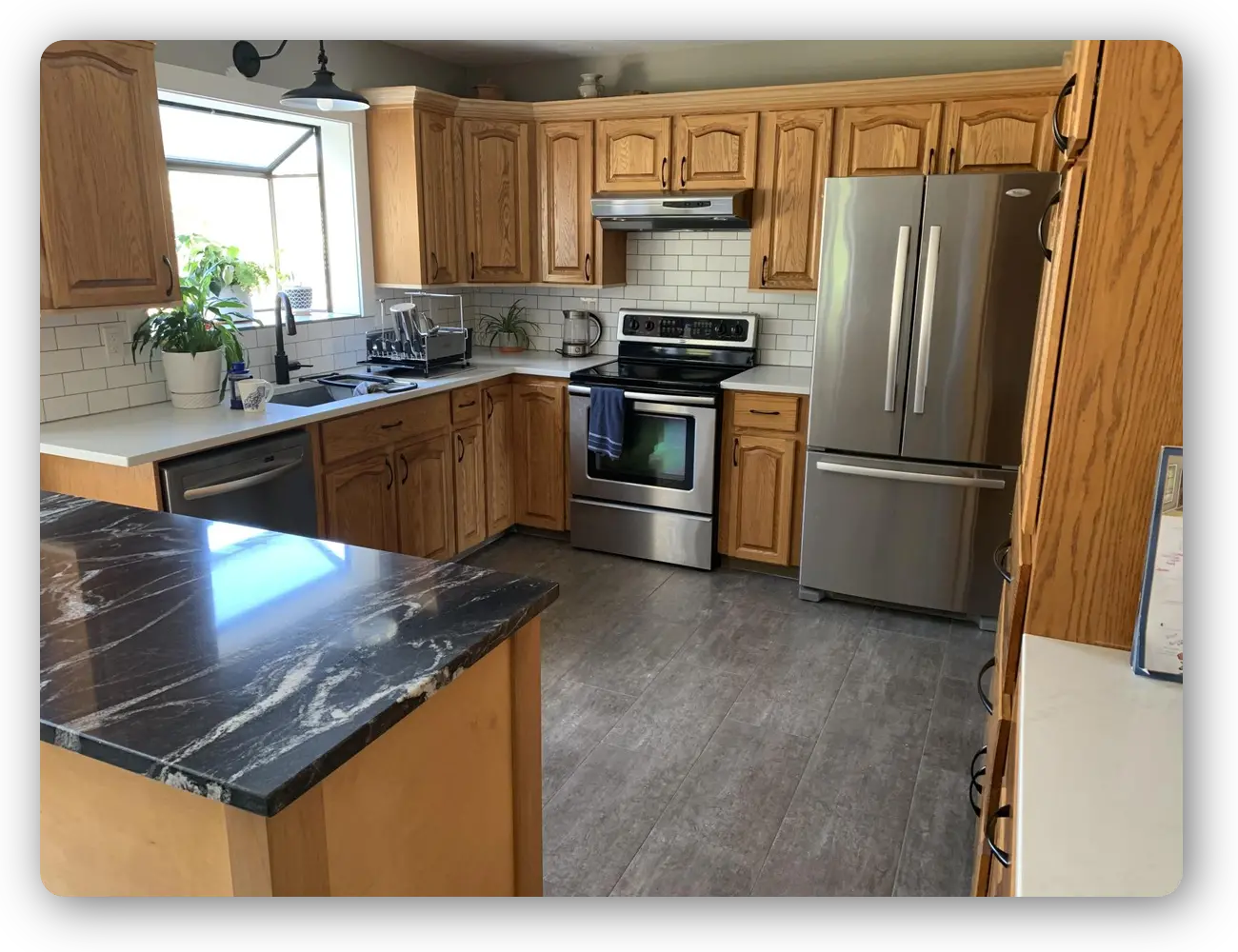
Step 2
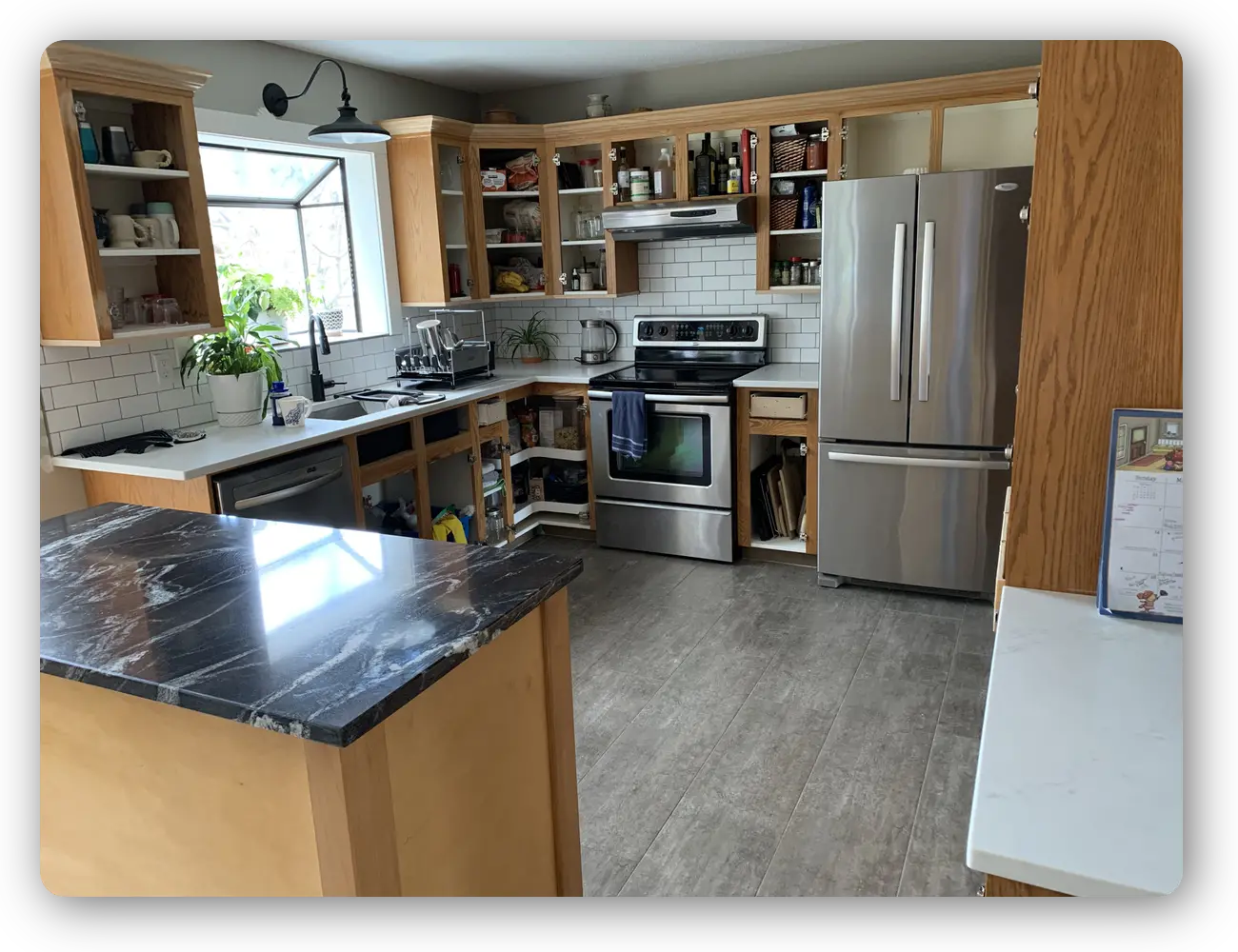
Step 3
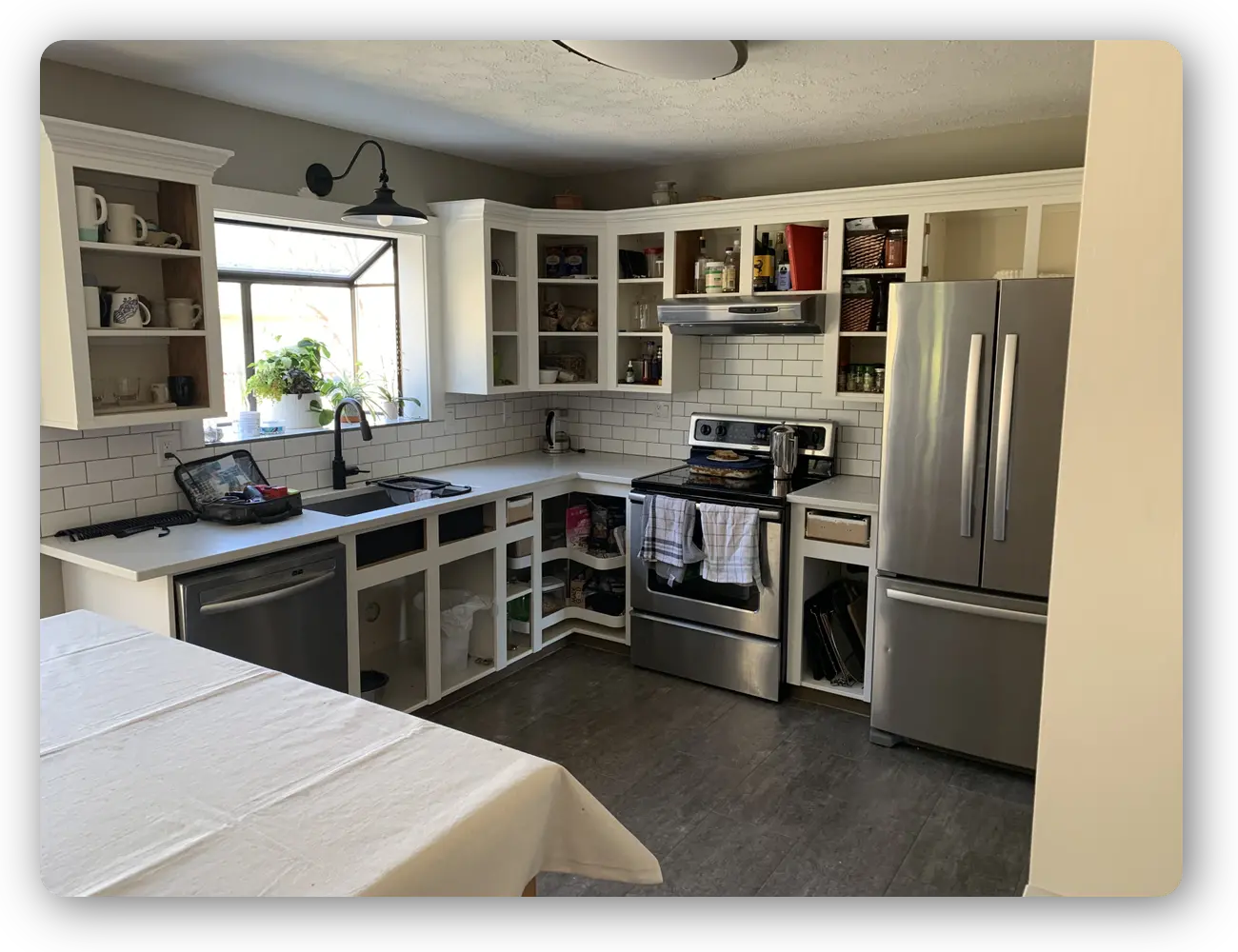
Step 4
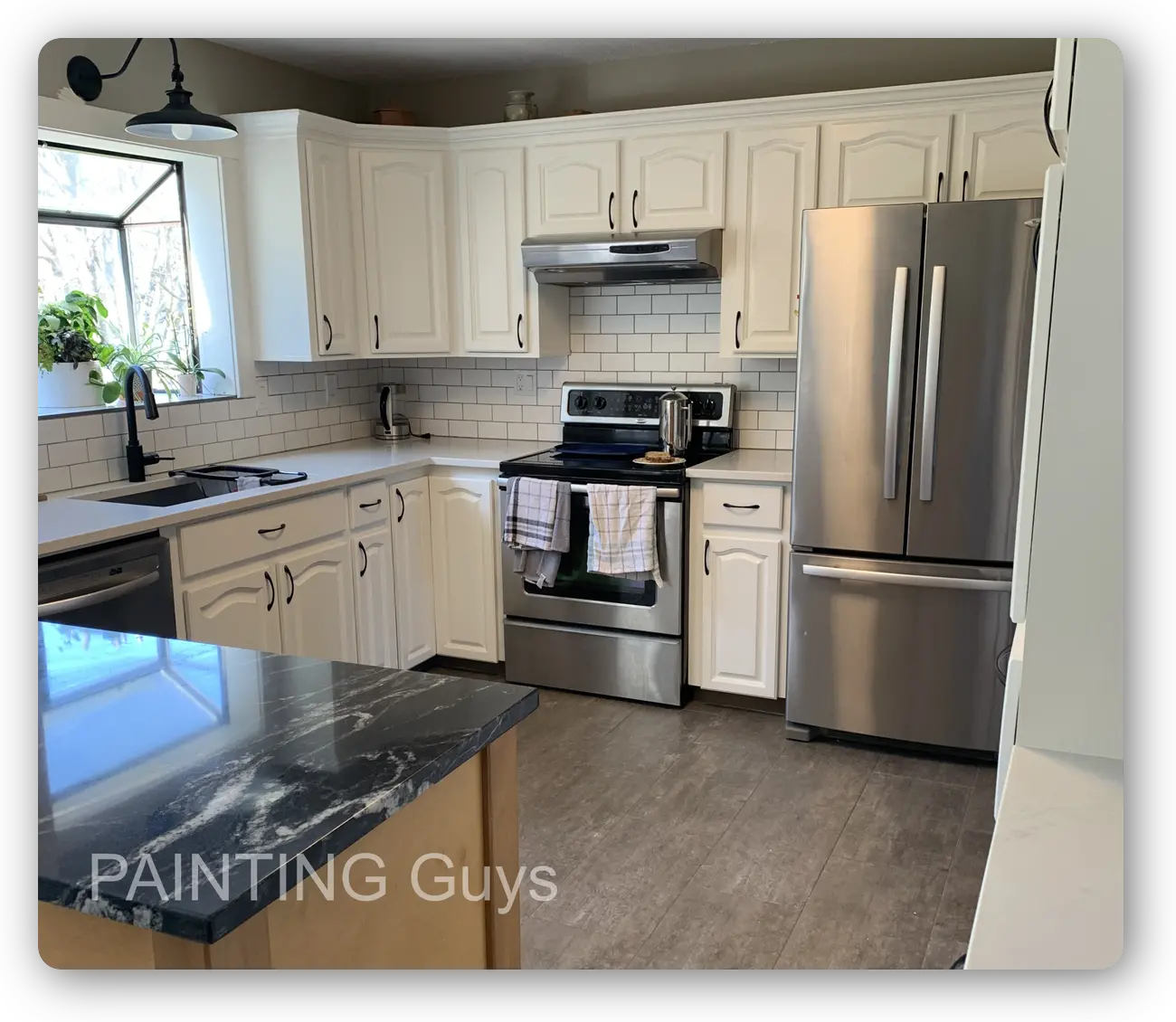
Can you paint your kitchen cabinets yourself?
Most people who've painted their cabinets never do it again. However, this doesn't mean you can't do it yourself (DIY).
If you are on a budget and are good with a brush and roller you can save thousands of dollars painting cabinets yourself!
Expectations
Painting cabinets is a tedious process that requires above-average painting skills. To avoid disappointments and costly mistakes, know your expectations before hiring someone or taking on the challenge to paint them yourself.
Once cabinets have been poorly painted, fixing them may cost more than it’s worth.
Chipping and cracking occurs when:
- Cabinets weren’t cleaned and sanded properly;
- Cabinets weren’t primed properly;
- Cabinets weren’t caulked properly;
- Cabinets weren’t painted properly.
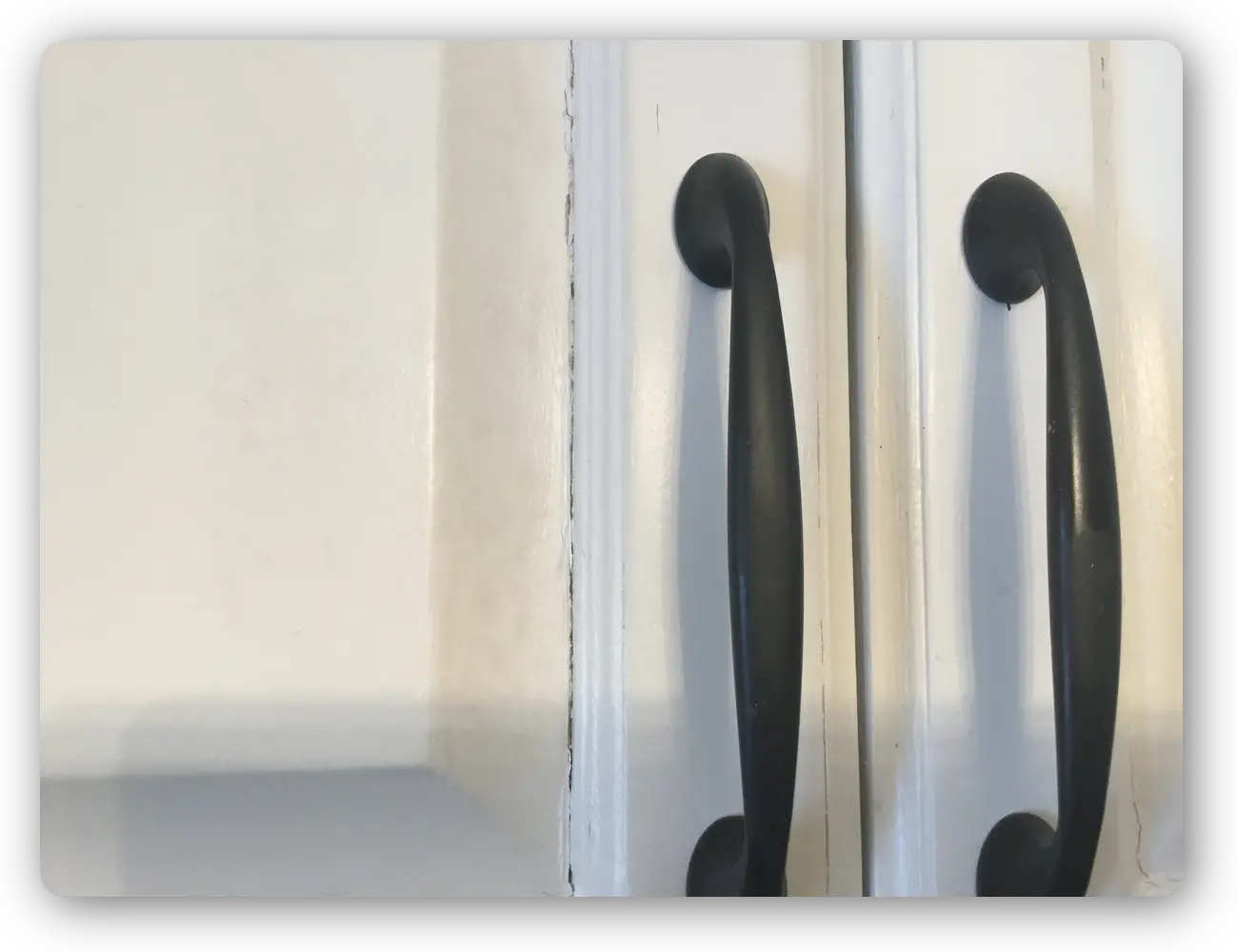
Scratch Test
Paint should never scratch off easily. If it does, this means your cabinets were not painted properly.
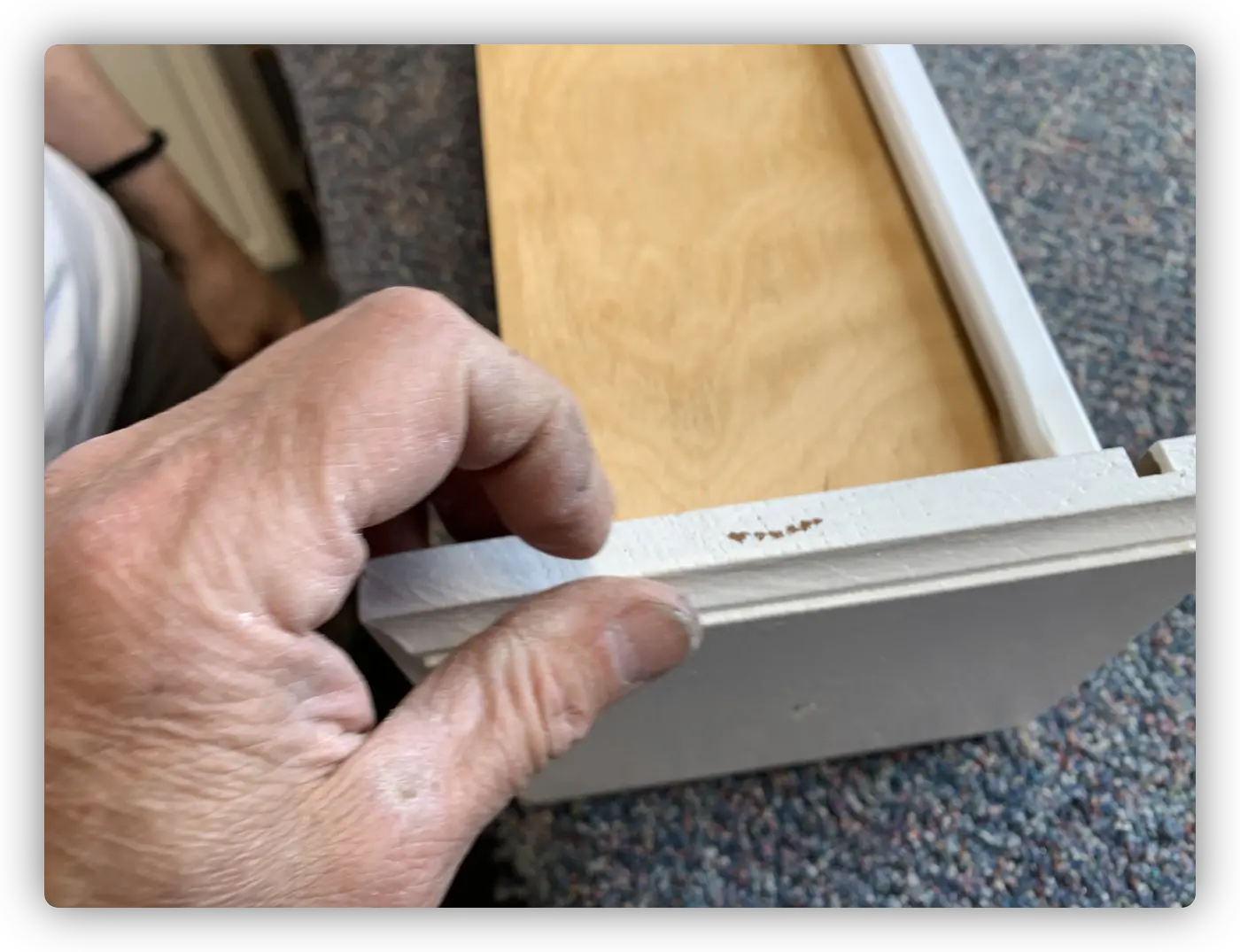
To avoid costly mistakes, hire a professional cabinet painter
- Cabinet painters are fine finishers able to hand-paint details to MATCH high-quality spray finishing;
- Cabinet painters usually have a painting and refinishing shop equipped with a spray booth, air extractions, and drying racks to produce new results;
- Kitchen Cabinet Painters would have the ability to pick up and deliver what they refinish without damage.
- Cabinet painters refinish kitchen cabinets to look new again.

Do you need to paint inside the cupboards?
Most cupboards are laminated with a durable surface so it's not necessary to paint inside them. However, if they are open shelves or behind glass doors, you will want the inside to match the exterior of the cabinets or decor.
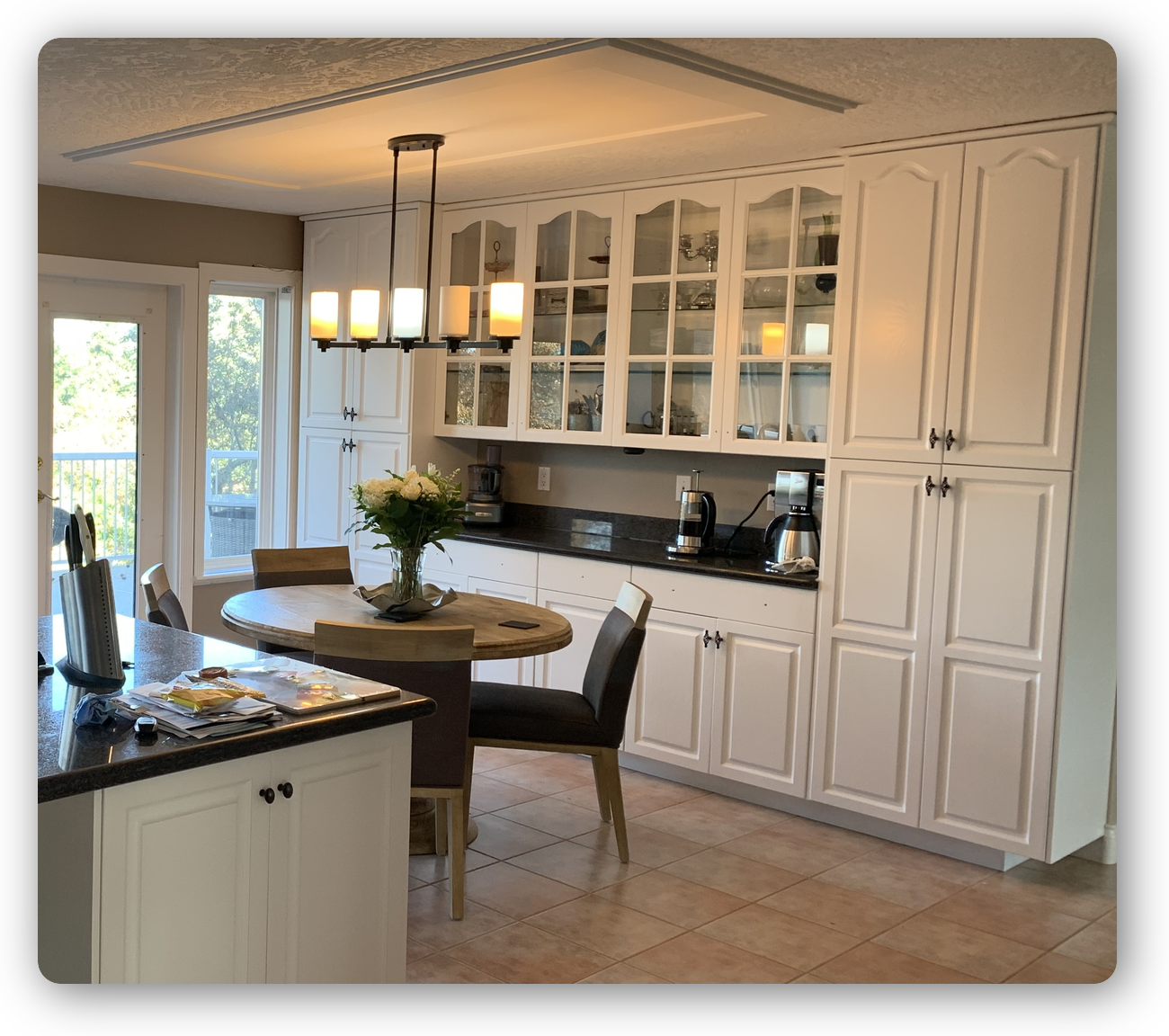
PAINTING Guys History and Experience
PAINTING Guys have been in the painting & wood finishing business since 1975.
We are professionally trained refinishing painters with over 40 years of experience in high-end residential and commercial painting.
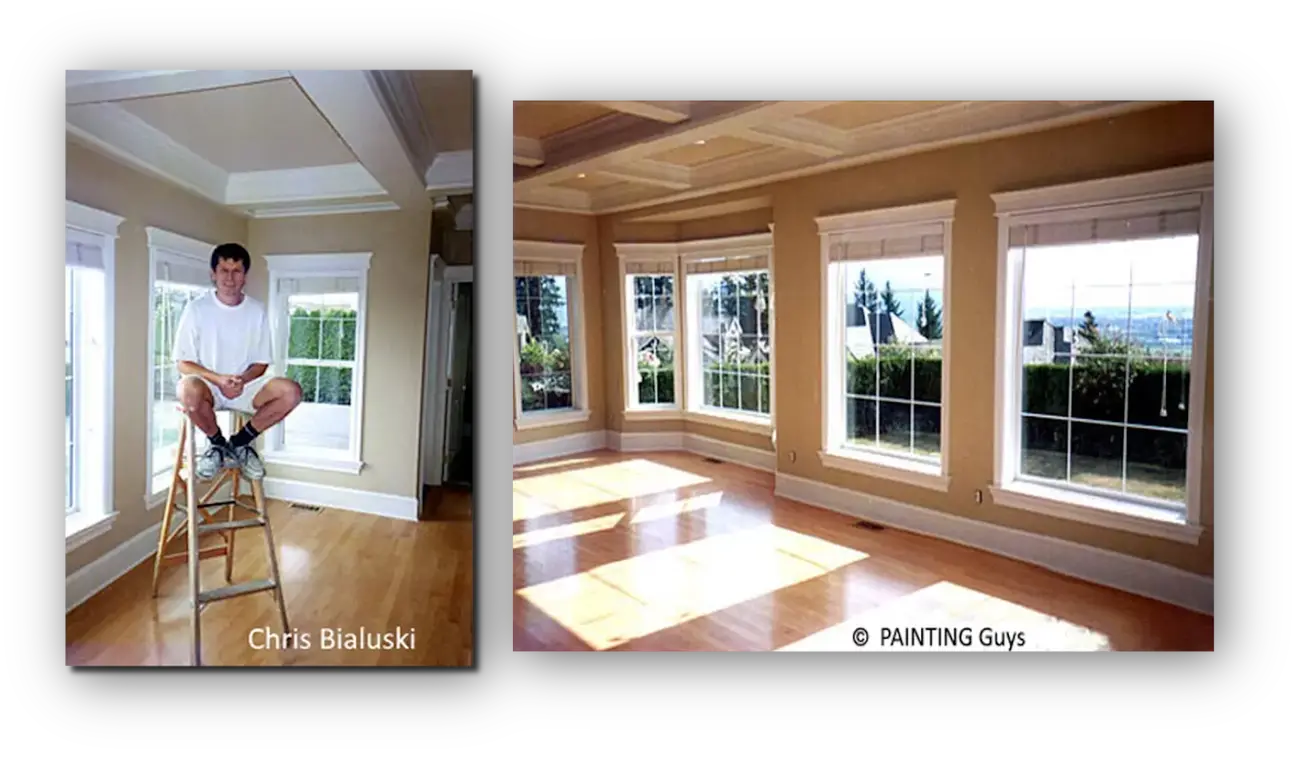
Painting Cabinets Without a Shop 👎🏻
When we first started painting cabinets we didn't have a shop. We had to spray cupboards on-site and on the walls.
Although this method works, this is not how we paint kitchen cabinets today.
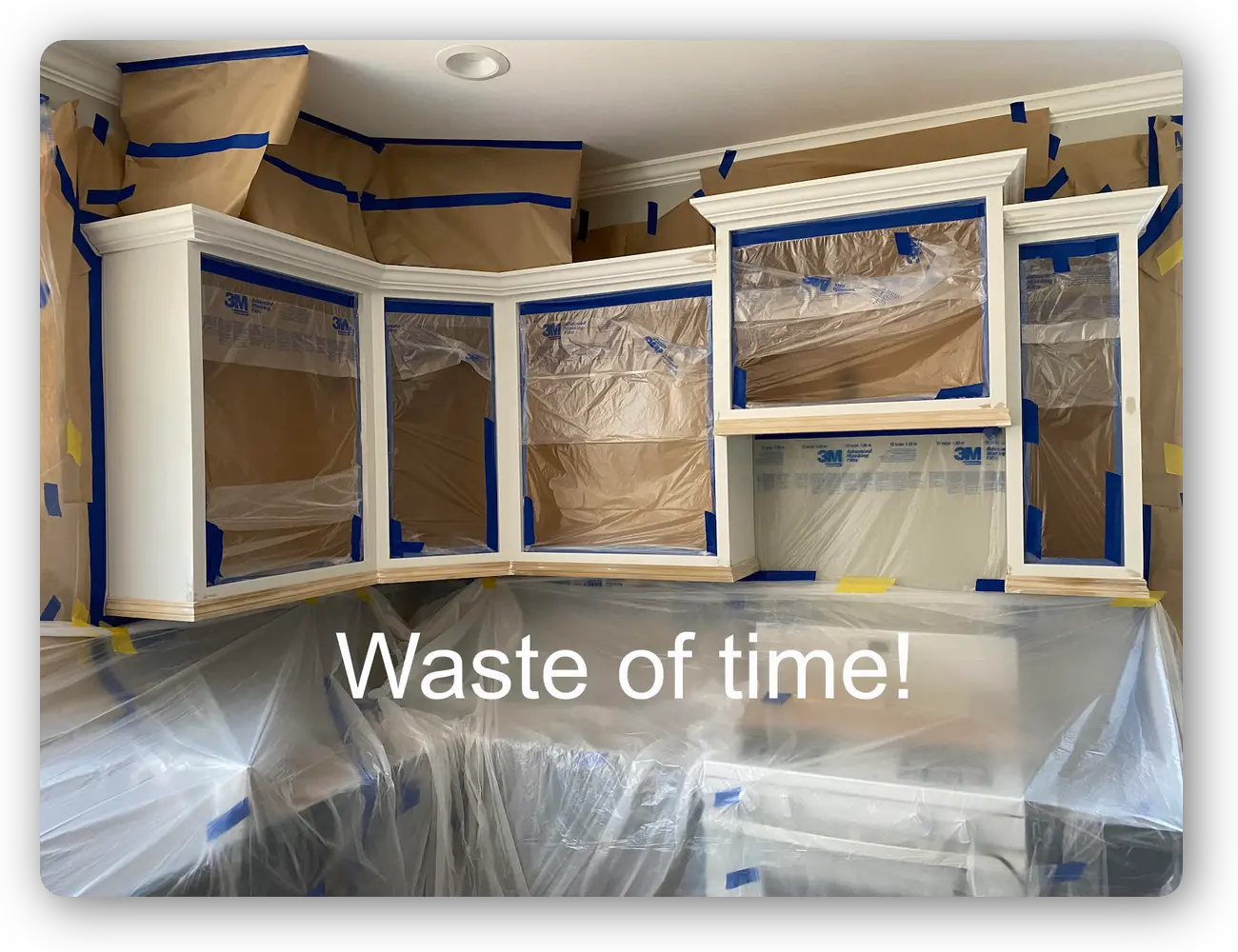
On-site spray painting has quality issues including, health-related issues for both the owner and painter ⚠️
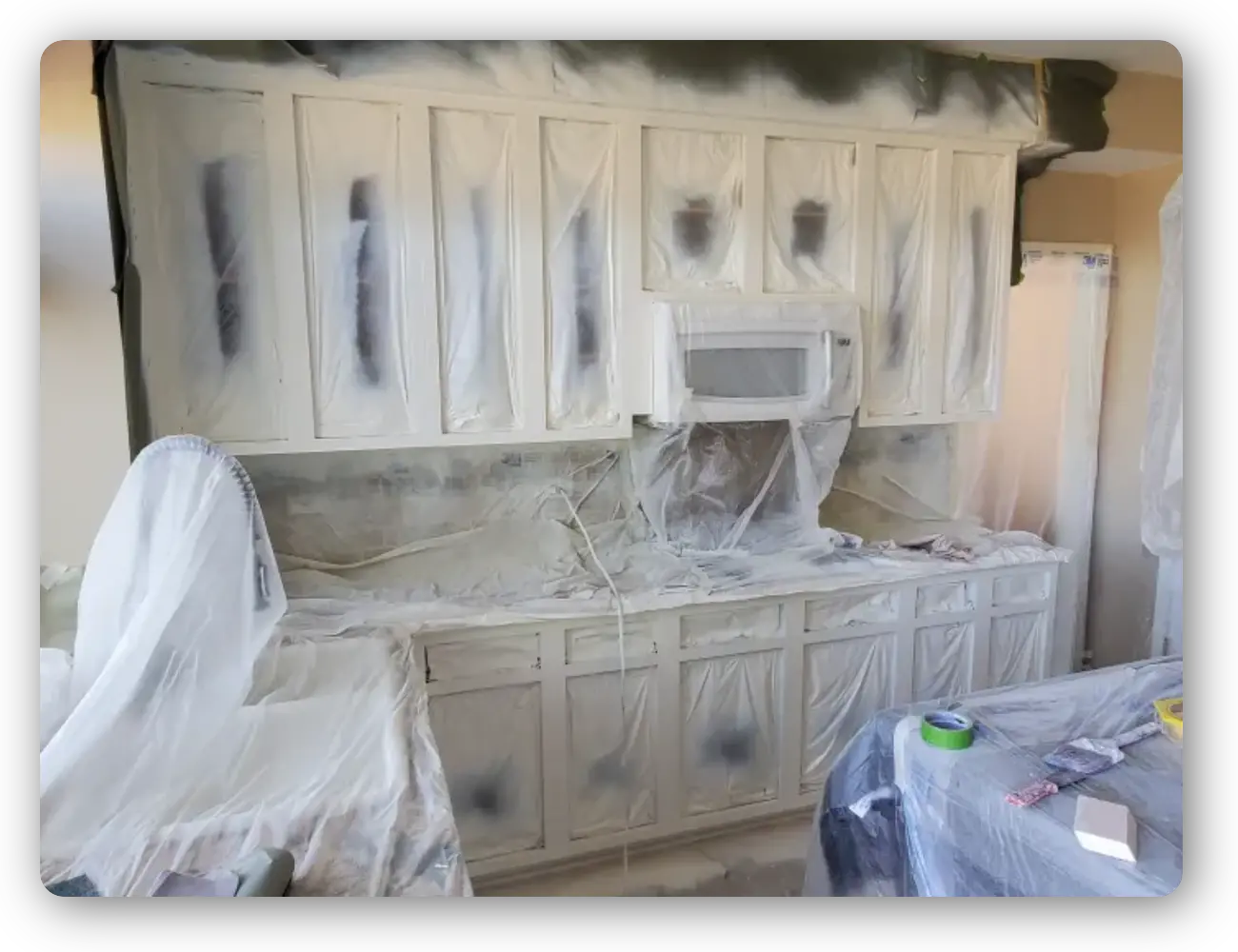
Toxic Dust and Fumes
Dust produced from sanding and spraying is unhealthy and very problematic to how smooth the finish will be. Dust from sanding old lead-based finishes fills the space you are working in making it the absolute worst environment.
Off-gases from sanding and spray painting are extremely toxic which is why we use carbon filter masks and spray everything in a shop equipped with an air extraction system.
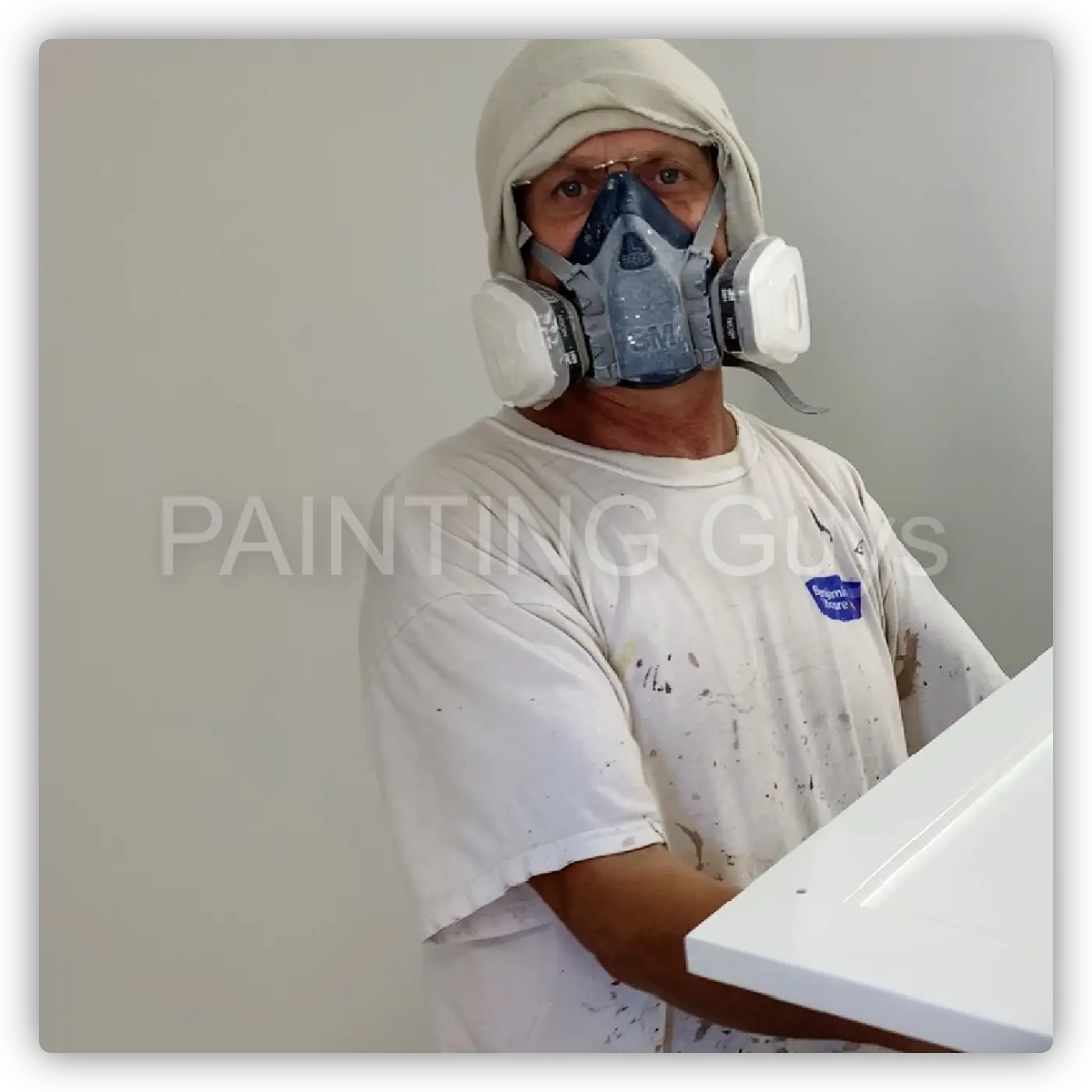
How to produce a durable long-lasting factory-smooth finish
The best finish begins with proper cleaning, sanding and spray painting all the doors and drawers in a dust-free environment.
Spray Painting Shop
Off-site spray painting 👍🏼
To improve the spray finish we knew we needed an off-site painting shop equipped with a spray booth, air extraction, and drying racks so the doors and drawers lay flat while drying and curing properly in a dust-free environment.
You cannot get the same result spraying cabinets in someone’s home period.
Drying Racks
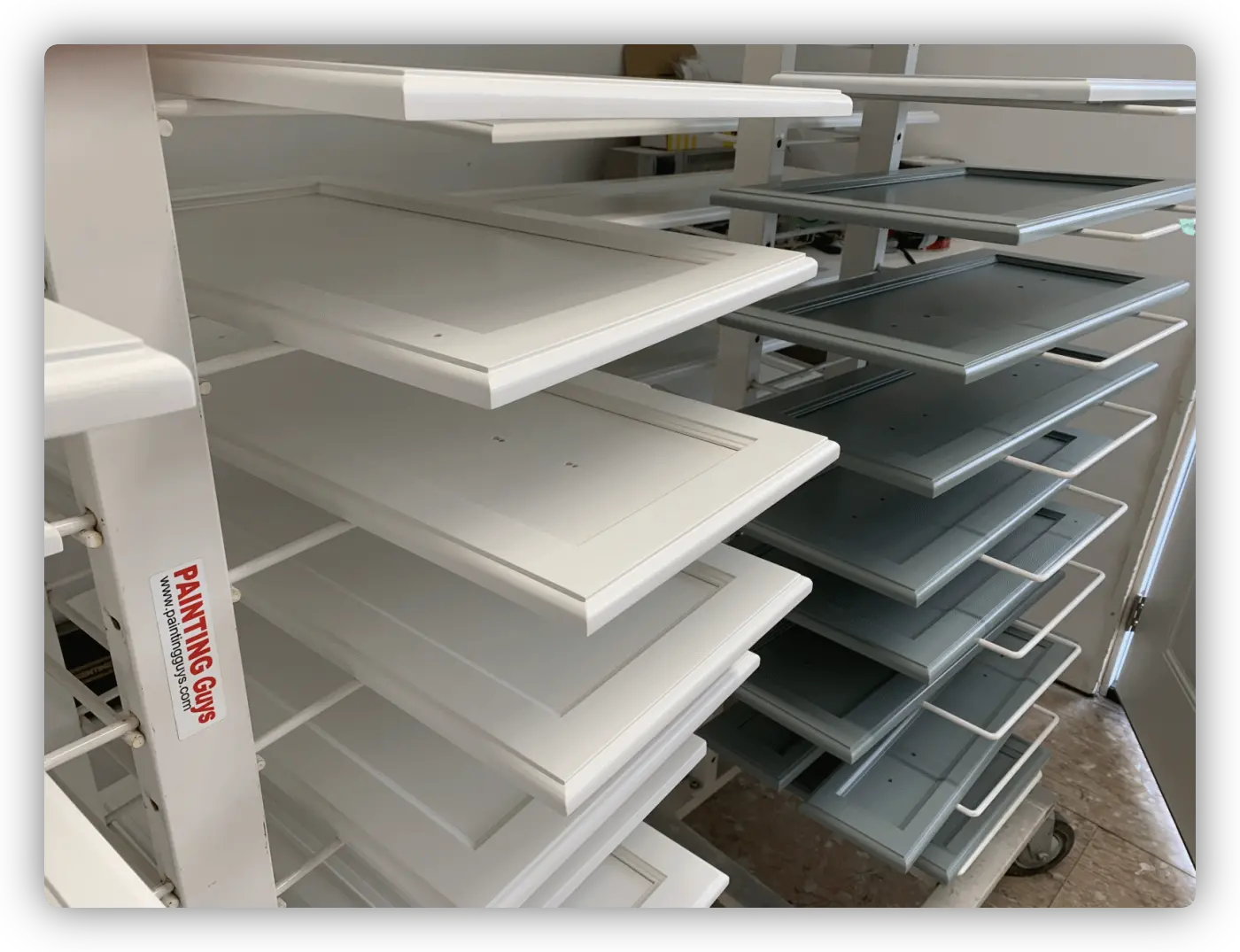
Spray-painted doors and drawers
A big part to cabinet painting revolves all around how well the doors and drawers are refinished. When they look good, everything looks better!
Our doors and drawers look awesome.

Clean before painting
Never use Trisodium phosphate (TSP) heavy-duty degreaser as a substitute for cleaning or sanding. TSP will cause a chemical incompatibility issue with primers. Always read the labels before you use the product.
If you are washing cabinets before priming do not get an excessive amount of water between the gaps and seams of the doors and drawer because this will cause swelling and expansion.
The best way to prep cabinets for painting is by using a scraper and sanding
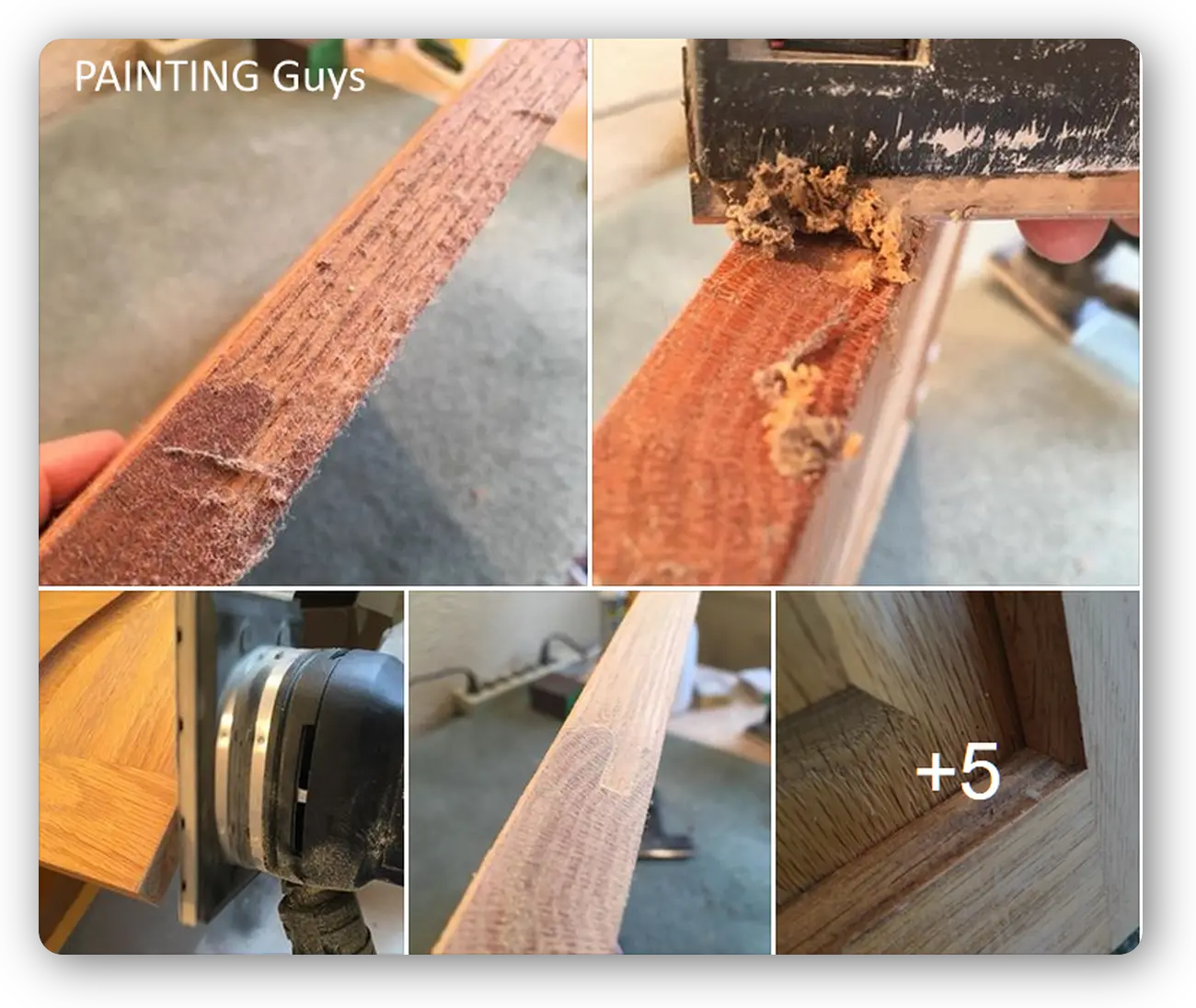
Do we sand cabinets?
We sand all of the cabinet doors, drawers and cabinet boxes before priming and painting. Sanding cabinets is essential in achieving proper adhesion over existing lacquer finishes. Sanding cabinets is how you make kitchen cabinets look like new again.
When it comes to refinishing older kitchen cabinets, if you do not sand everything properly, the finish will not only look cheap but it can also scratch or peel much easier. Sanding the old finish down to clean wood, patching dents, and fixing cracks is how to properly refinish cabinets to look like new again! This process is particularly important when refinishing darker stained cabinets to a lighter colour and shade of white.
Sanding is the nasty part of cabinet refinishing and there is no fast and cheap way to do it without compromising the end result. Refinishing the doors and drawers requires about a week to sand, clean, patch, and allow the spray finish to set and cure properly before reassembling back in the home.
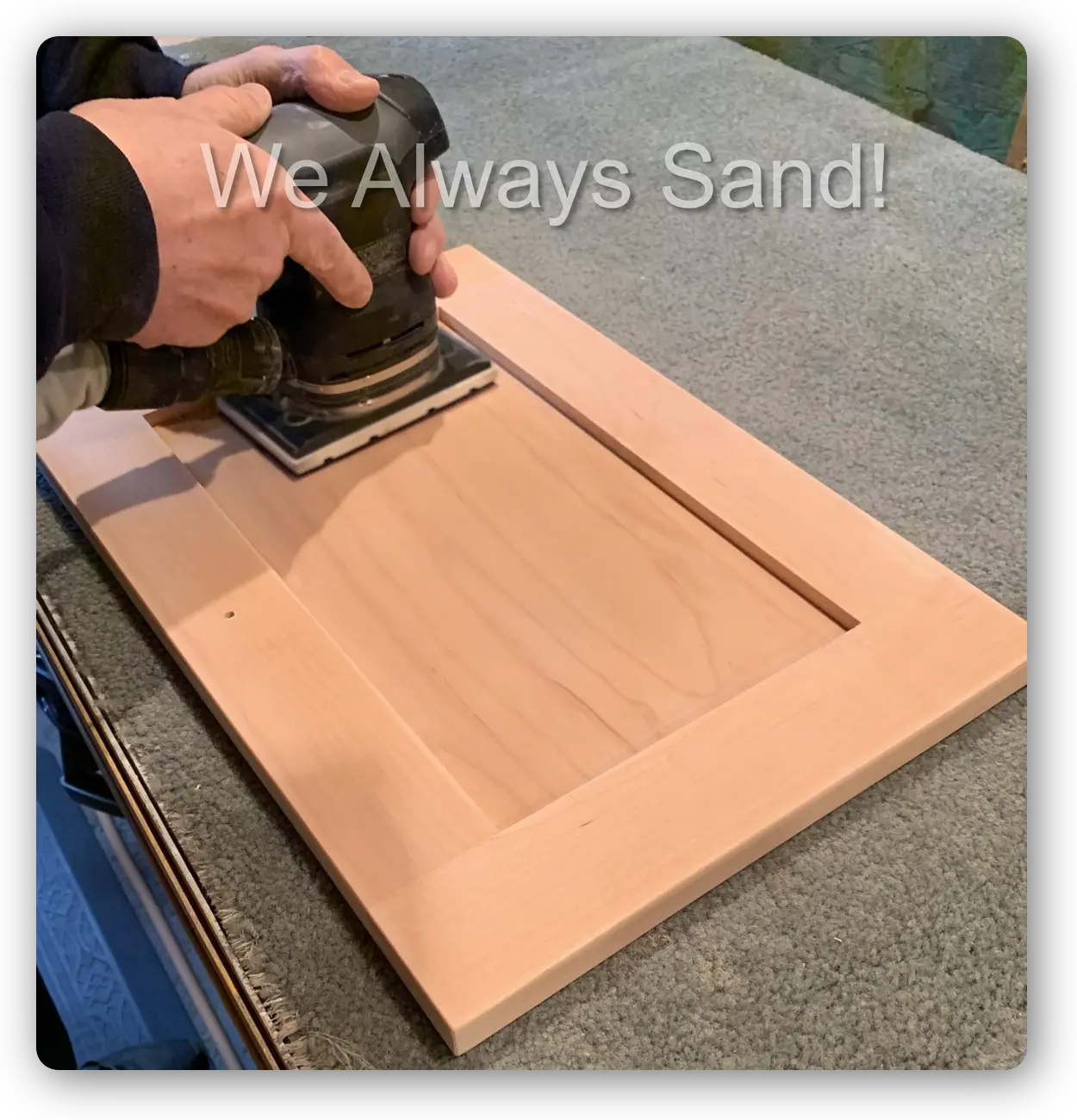
Dealing with dust
We use HEPA-filtered dustless sanders to contain and collect dust from sanding cabinets. Our process is very clean.
Drying racks!
Freshly spray-painted doors and drawers that are placed on drying racks in a vented dust-free environment ensure a satin smooth finish every time!
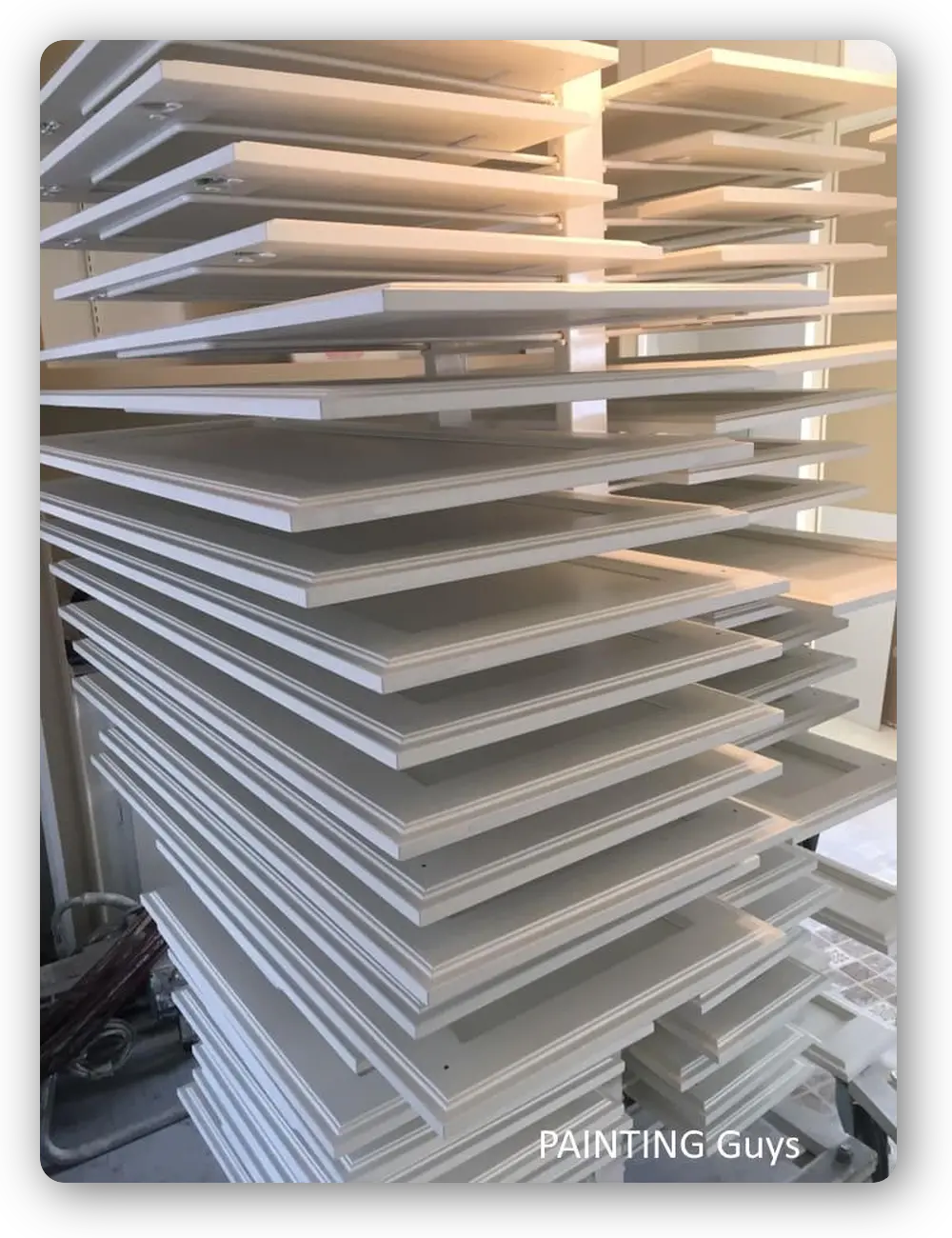
Painting exterior sections of the cabinets and cupboards
The exterior sections of the kitchen cabinets, which include the face frames, any exposed cupboards, shelving, crowns, valances, gable ends, and kick plates are always done by hand before finish coating.
These sections should be cleaned, sanded, sealed, and undercoated in place so they do not expose old stains, bleed, or any gaps around the walls and ceiling. This is why you do not remove these section and why you take the time to allow everything to cure.
Other than having cabinets without the doors and drawer fronts on them, you are able to use your kitchen throughout our entire process and you do not have to empty the cupboards!
Continue using your kitchen during the entire process!
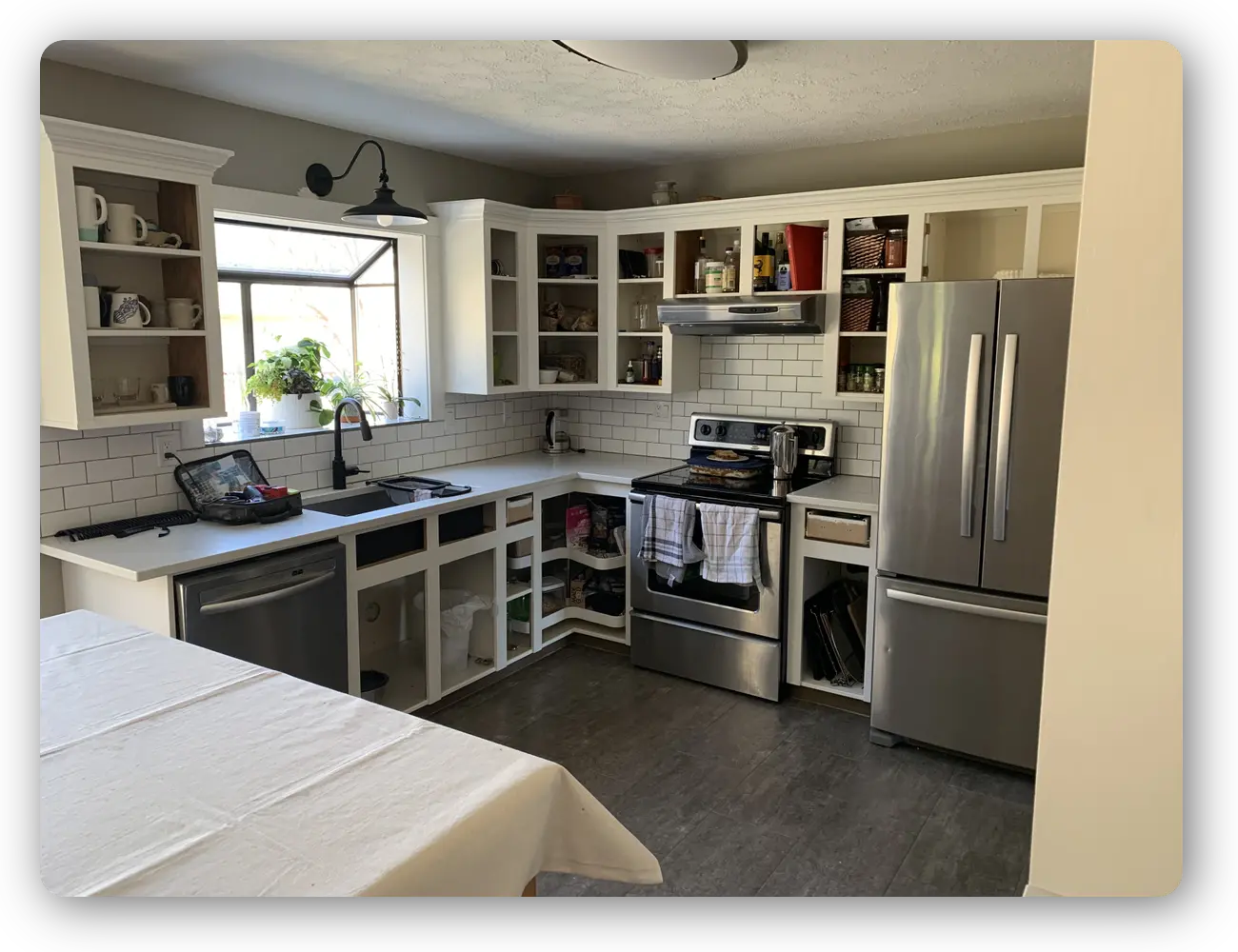
Painting crowns, valances, and trim
When the goal is to repaint any previously stained cabinet "to look new again", do not remove crowns, valances, or any trim that will show old stains between cracks, joints, and seams. Sealing everything in tack is how you do it and always use high-quality paint-able products that do not shrink at different cure speeds of the top coat.
Always allow everything time to cure before finish coating. You do not want anything to crack open 12 months down the road.
Quality vs speed drying painting products
We do not use chemical-based products to speed up the drying and curing process (formulate the coatings). Quick dry chemicals tend to be more brittle and problematic to cracking around seams and joints as seen in the example below. This is why we take time to prep and refinish cabinets properly using latex and acrylic-based products. The downside is these products take a few days to cure between our steps but in the long run these products also stands the test of time.
Lacquer vs Paint, which is better?
When it comes to refinishing older kitchen cabinets to be painted, which is better to use, lacquer, pre- or post-catalyzed lacquer (epoxy formula), or paint?
Below is an example of why we don’t use pre- or post-catalyzed lacquer (epoxy formula). Example of a pigment lacquer cabinet door finish failing only after a few years. Pre or post-catalyzed lacquer (epoxy formula) fails like the rest of the finishes, especially if they weren’t primed properly.
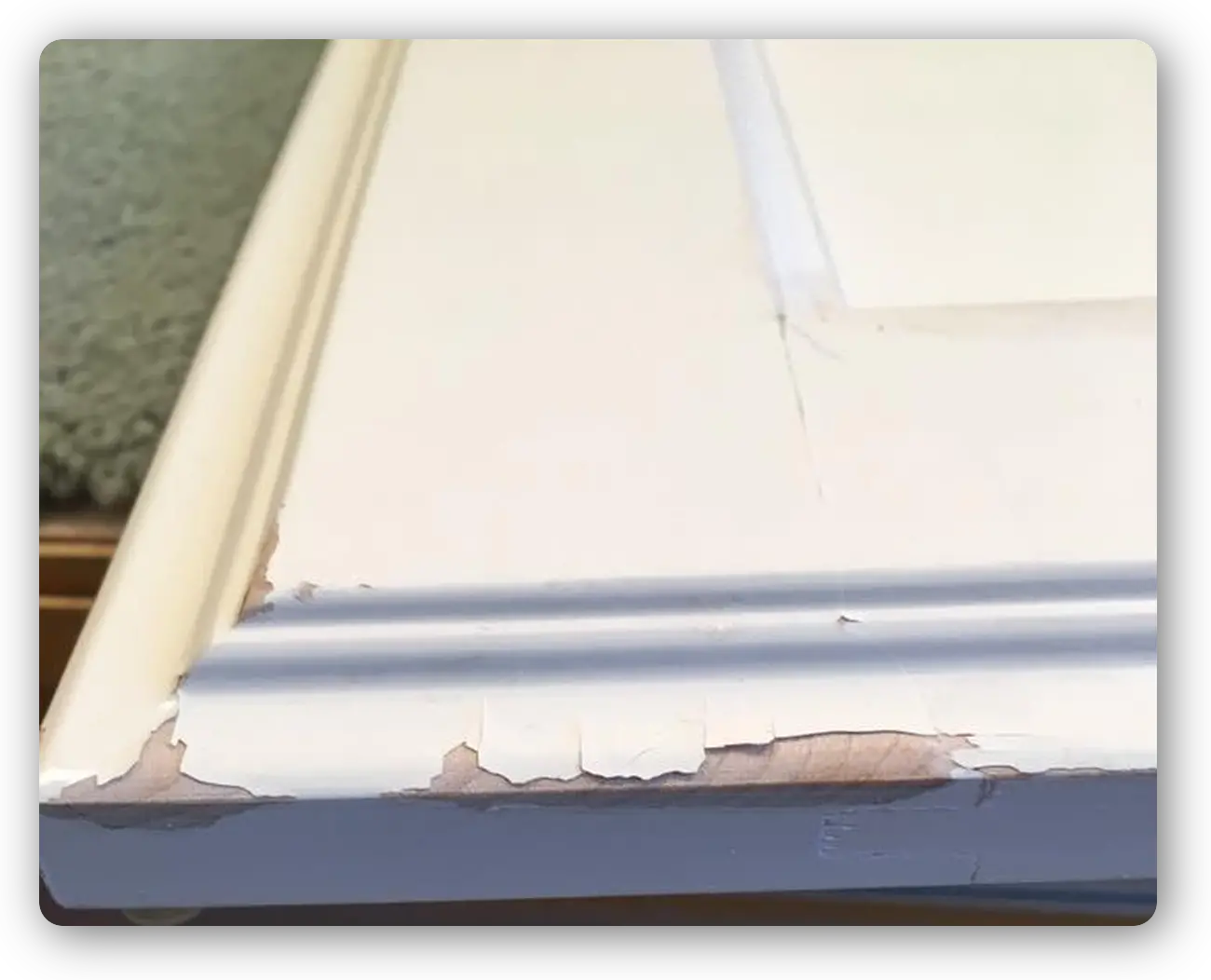
Climate and humidity
Most stained cabinet panels are designed to expand and contract throughout seasonal climate changes. When this happens the gaps between the panels are purposefully stained so you do not notice this happening. But when you paint older cabinets for example white… the gaps between the panels and seam can become very noticeable and unsightly. Therefore, when it comes to repainting older cabinets we need to overcome the dark gaps from suddenly appearing and exposing old stains.
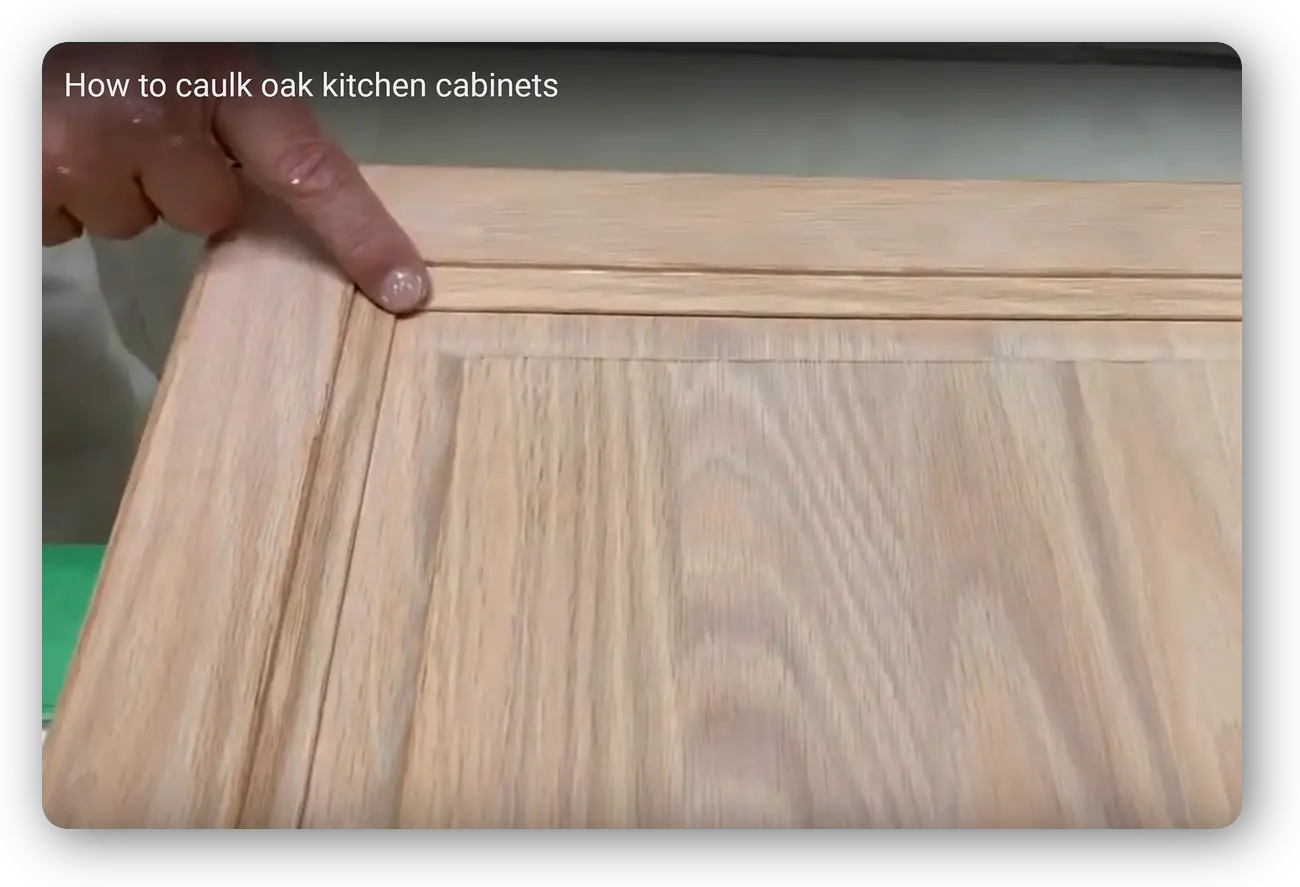
- To overcome these issues we clean the joints, vacuum dust and hand-paint shellac-based bonding primer into these gaps and joints. This process cannot be done with sprayers. It must be done by hand.
- After priming we use high-end caulk and acrylic paint because these products expand and contract far better than composites, lacquer or alkyds as these products are prone to cracking over time.
Painting products that bond and work together to prevent down-the-road warranty problems.
Spraying cupboards on walls
Most residential painting contractors that include "kitchen cabinet painting" as part of their service will set up a "spray net" to help reduce dust and fumes from entering the house.
Once this is done they mask off the cupboards and shelving so they can spray paint everything without getting paint all over the ceiling, walls, inside the cupboards, flooring, etc.
We DO NOT Paint cupboards like this! 👎🏻

Why is this not the best way paint cupboards?
Spraying cupboards on walls creates excessive paint build-up and over-spray from the back pressure. You can reduce this pressure using an HVLP but the problem still exists.
When too much paint is applied on the cupboards the paint chips much easier, breaking between the seams and joints. This is especially problematic when painting all open-grain wood such as oak cabinets.
If we could get the same results spraying cabinets on the walls, we wouldn’t need a paint shop and all the equipment.
Detail Hand Painting
Part of this beautiful built-in refrigerator cabinet was sprayed and other sections were hand-painted. Being able to seamlessly paint what cannot or should not be disassembled is why we have decades of thrilled clients throughout Western Canada.
Hand painting the shells always looks far superior to taped-off make-shift spraying. Tape lines look cheap and tend to bleed and chip at the seams of the tape lines.
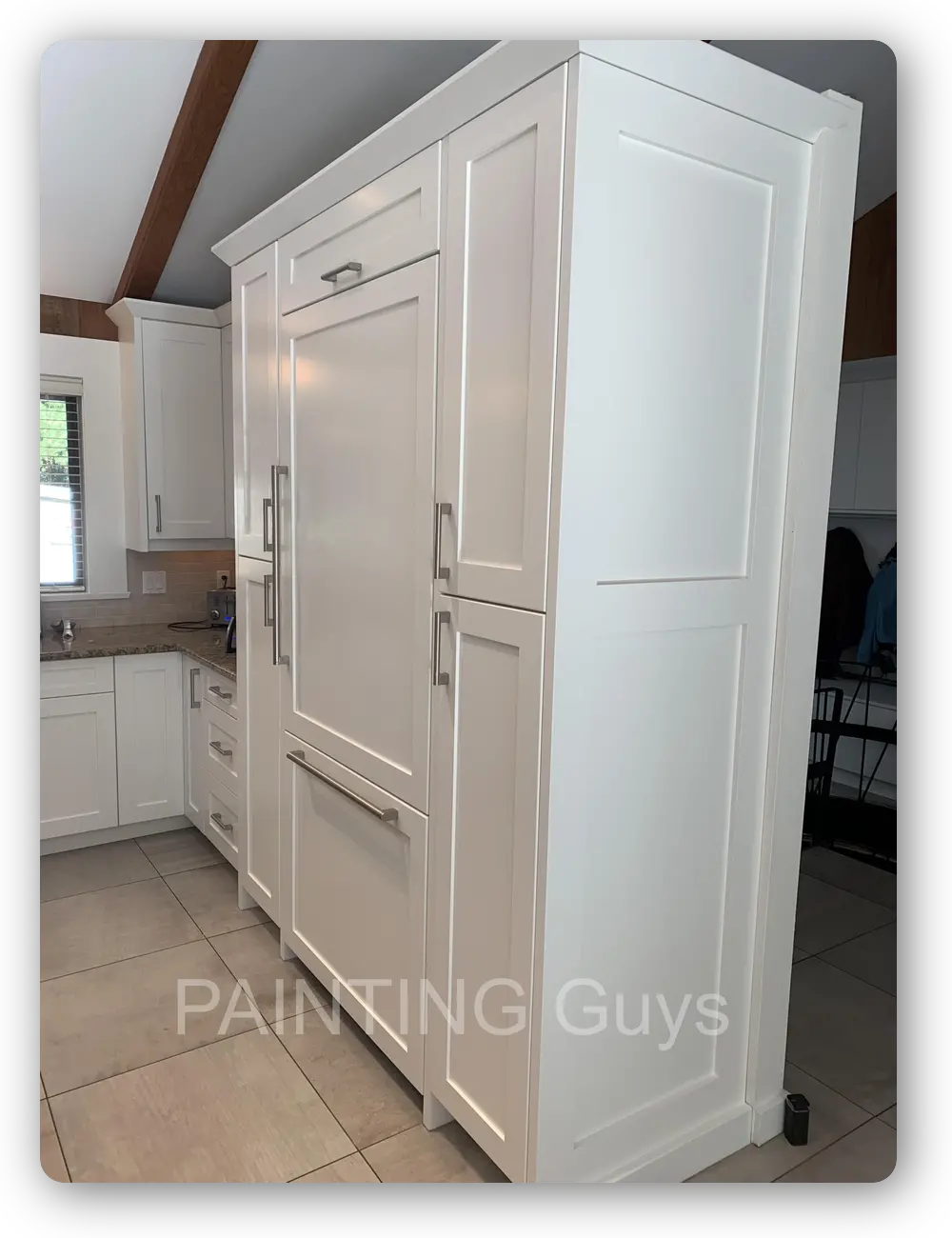
Install new bumpers
We only use felt bumpers!
Clear plastic bumpers tend to stick and become gooey over time.
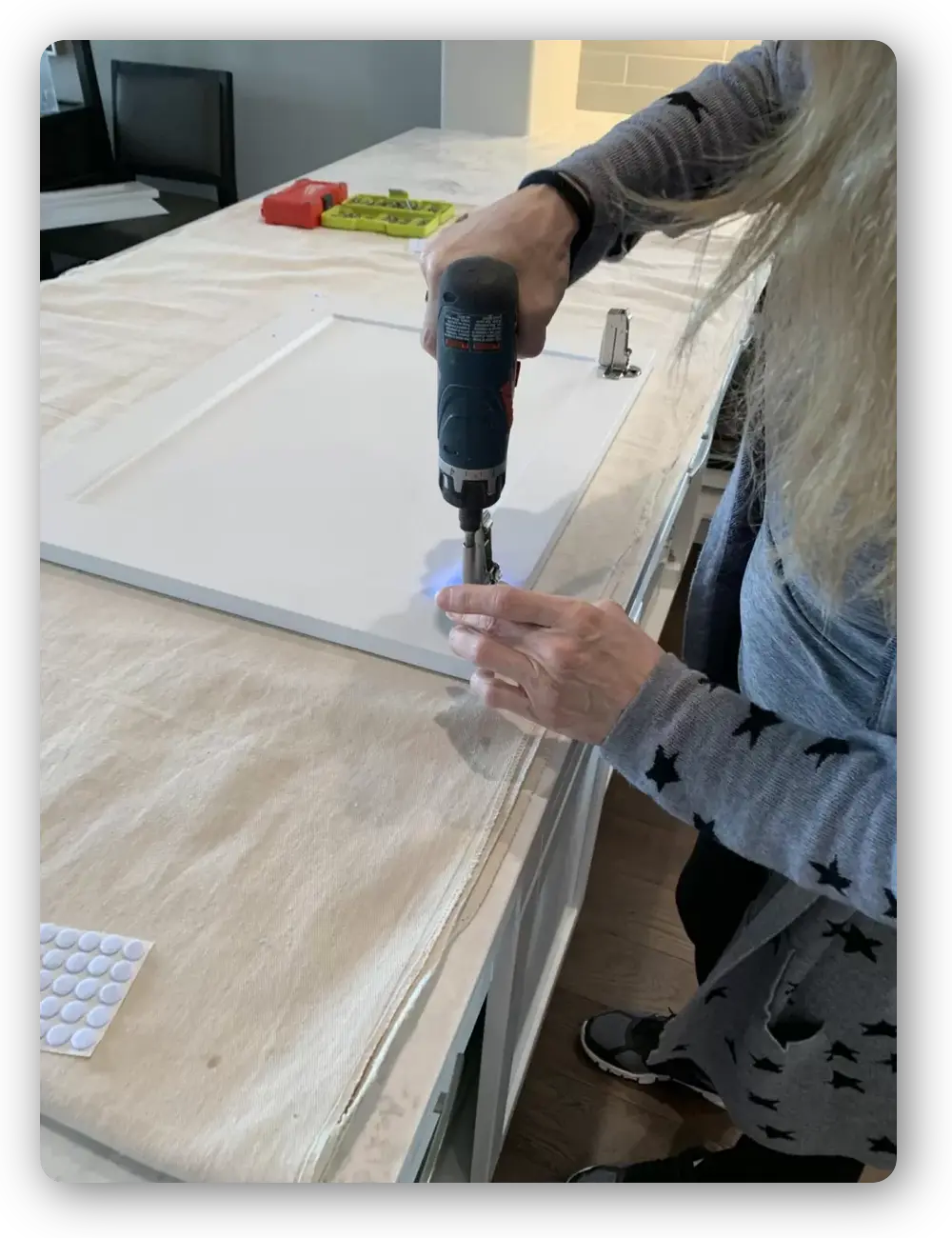
The Finished Product!
On the last day of the process we return back with the beautifully spray painted doors and drawers to complete the finish coating of the cupboards.
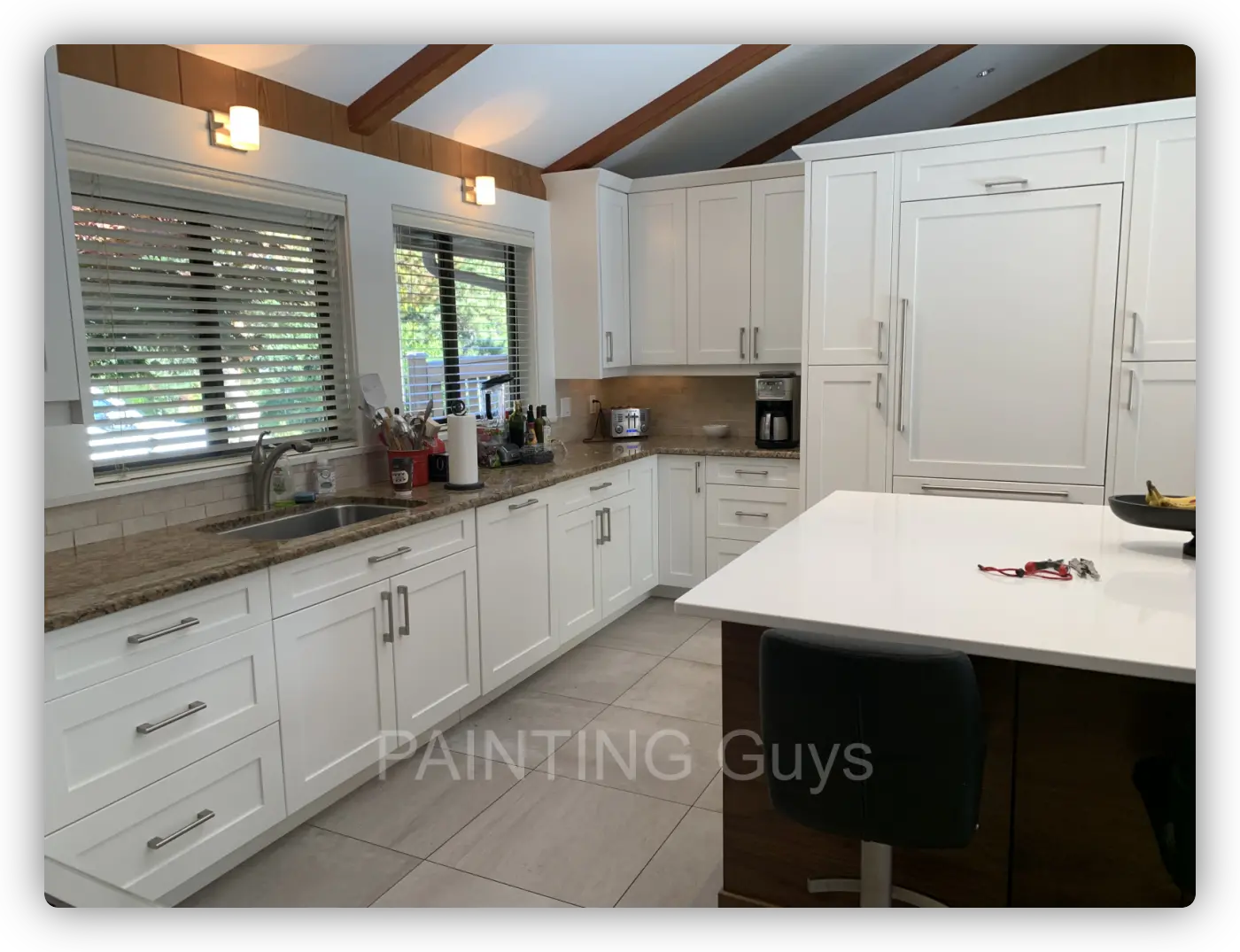
Mission Statement:
Our goal is to achieve the best-looking cabinet refinishing possible. We never rush and do not call it a day until we've achieved the best results possible.
When everything is put back together the result is always amazing. Kitchen cabinet painting is definitely worth every dime spent. Our clients are constantly amazed by how beautiful their kitchen cabinets look!
Beautiful kitchen cabinet painting
